The blog for Mets fans
who like to read
ABOUT US

Faith and Fear in Flushing made its debut on Feb. 16, 2005, the brainchild of two longtime friends and lifelong Met fans.
Greg Prince discovered the Mets when he was 6, during the magical summer of 1969. He is a Long Island-based writer, editor and communications consultant. Contact him here.
Jason Fry is a Brooklyn writer whose first memories include his mom leaping up and down cheering for Rusty Staub. Check out his other writing here.
Got something to say? Leave a comment, or email us at faithandfear@gmail.com. (Sorry, but we have no interest in ads, sponsored content or guest posts.)
Need our RSS feed? It's here.
Visit our Facebook page, or drop by the personal pages for Greg and Jason.
Or follow us on Twitter: Here's Greg, and here's Jason.
|
by Greg Prince on 13 February 2024 11:09 pm The studio has a few notes on the next installment of MY FAVORITE SEASONS, FROM LEAST FAVORITE TO MOST FAVORITE, 1969-PRESENT.
***19. 1998
First off, we love the concept. The Mets as a team you go into the season having expectations for is fresh. I mean, it’s not like it hasn’t been done before, but it will feel fresh to this audience. Our research shows most of our potential ticket-buyers can’t remember the last time they entered a season thinking things would turn out well.
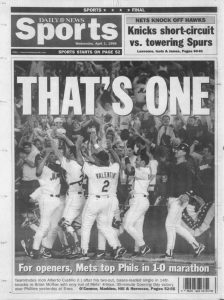 The end of the first act, where you introduce the superstar — unorthodox for timing, but effective. It might have worked better if you could have had him from the beginning of the story, but once you work him in there, he’s a blockbuster unto himself. We’re gonna put him on the posters and everything. The end of the first act, where you introduce the superstar — unorthodox for timing, but effective. It might have worked better if you could have had him from the beginning of the story, but once you work him in there, he’s a blockbuster unto himself. We’re gonna put him on the posters and everything.
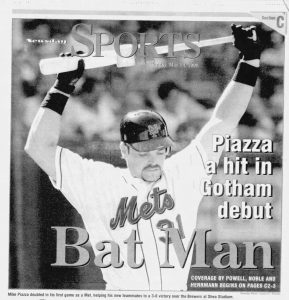 We like some of the supporting cast. The first baseman, for example, is a natural. The hard hat he wears everywhere is supposed to be what, his trademark? Whatever it is, it’s unique. We think it might test well. His hitting you shouldn’t change at all. We like some of the supporting cast. The first baseman, for example, is a natural. The hard hat he wears everywhere is supposed to be what, his trademark? Whatever it is, it’s unique. We think it might test well. His hitting you shouldn’t change at all.
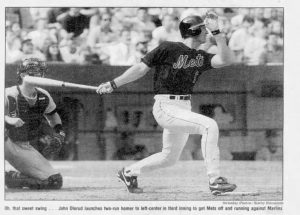 The rest of the infield is…interesting. Listen, we love the scenes where the shortstop fields. Those test off the charts. Well worth the special effects budget that I assume is needed to make him fly through the air. Could he be made into more of a hitter, though? Something to think about. His friend the third baseman plays well in his role, but we hear he has some versatility, and you might want to try him in the part of the second baseman. Nothing wrong with him at third, mind you, but we absolutely have to recast the second baseman. The rest of the infield is…interesting. Listen, we love the scenes where the shortstop fields. Those test off the charts. Well worth the special effects budget that I assume is needed to make him fly through the air. Could he be made into more of a hitter, though? Something to think about. His friend the third baseman plays well in his role, but we hear he has some versatility, and you might want to try him in the part of the second baseman. Nothing wrong with him at third, mind you, but we absolutely have to recast the second baseman.
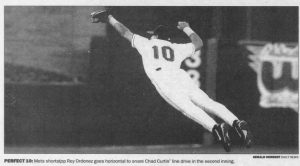 For starters, and this is the superficial stuff, does the second baseman have to have a mustache? The superstar has a mustache. You really shouldn’t confuse the audience. One mustache grabs your attention. Two is…I don’t know, but it’s too hairy. Unless Charlie Finley is producing your picture, I don’t think the second mustache will fly. Even with special effects. For starters, and this is the superficial stuff, does the second baseman have to have a mustache? The superstar has a mustache. You really shouldn’t confuse the audience. One mustache grabs your attention. Two is…I don’t know, but it’s too hairy. Unless Charlie Finley is producing your picture, I don’t think the second mustache will fly. Even with special effects.
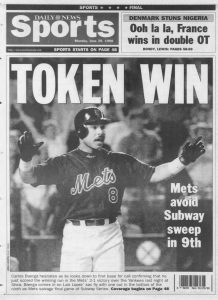 But never mind the face. The body is…I also don’t know, but it’s not that of a dynamic infielder. We need to recast. Or, better yet, take the third baseman — our test audiences really like him — and put him on second, where can form a relationship with the shortstop, and we find somebody else to play the third baseman. That could really make the infield a character unto itself. But never mind the face. The body is…I also don’t know, but it’s not that of a dynamic infielder. We need to recast. Or, better yet, take the third baseman — our test audiences really like him — and put him on second, where can form a relationship with the shortstop, and we find somebody else to play the third baseman. That could really make the infield a character unto itself.
Listen, you’ve got bigger problems in the outfield. You’ve got a motley assortment of players who don’t test well, players who don’t bring in the numbers, and what’s with the former star catcher in left field? We’re gonna have to talk about finding some new outfielders. We have a couple of intriguing names for you to look at later.
The starting pitching…people are not going to pay good money to see this starting pitching. They don’t dislike it, per se, but it’s not a draw. Fix that. Maybe you can get the bullpen in some of these scenes sooner. They’re more interesting. The closer who’s seen it all around here. The still-effective lefty journeyman who’s making his umpteenth stop on the circuit. The flaky one slamming that thing on the mound. We can merchandise that.
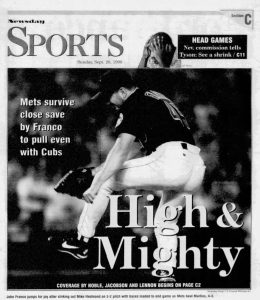 I know the closer has a mustache, but that’s OK. He’s a pitcher. The superstar is a catcher. They just can’t wear the same number is all. I know the closer has a mustache, but that’s OK. He’s a pitcher. The superstar is a catcher. They just can’t wear the same number is all.
We love the character of the manager. He’s just off-center enough to keep your attention, just good enough at what he does that he seems believable. Is he based on anybody real? The general manager, on the other hand, may be a little too slick. I don’t see the manager and the general manager co-existing in this story. Not that big a deal maybe.
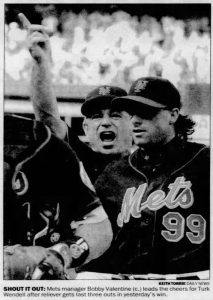 What I’m really concerned about is the story arc. We have the expectations at the beginning, swell. We have the superstar arrive when he does, the crowd eats it up. Again, off the charts with the testing. Even the adversity the superstar faces. He’s gotta have some reason to brood on the poster, am I right? What I’m really concerned about is the story arc. We have the expectations at the beginning, swell. We have the superstar arrive when he does, the crowd eats it up. Again, off the charts with the testing. Even the adversity the superstar faces. He’s gotta have some reason to brood on the poster, am I right?
You have the right idea about making this a story you can’t turn away from for the entire length of the picture. They’re trying to meet the expectations, which elevate in the middle of the arc, with the coming of the superstar, and they’re convincing everybody they just might if they can overcome their flaws, and the superstar and his mustache settle in, and the first baseman with the hard hat goes wild in his mild way, and that third baseman…maybe everybody calls him by a catchy nickname. The shortstop dazzles, even if he can’t hit…great. A couple of those starting pitchers come through. The debonair lefty tests well. The hardscrabble righty, too. I don’t know if you need the second pitcher from Japan, the…what’s he called? “Tornado”? Good nickname, but it could be confusing, like the mustaches. Yes, I know we signed off on him in concept, but we may have to rethink. It would be nice if we could call one of those starting pitcher characters “Ace,” but it might be taken as ironic. The flake reliever slamming the thing fits in any situation — we love that he’s used so often. Even that washed-up catcher who’s been exiled to the outfield who has one moment late in the picture moves the dials. You’ve got a lot of compelling scenes. Gripping, even.
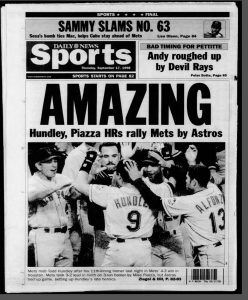 But does the end have to be so goddamn depressing? The whole bunch engages you all summer and keeps you hanging on into September and then in the last week we’re supposed to deal with them doing nothing but losing? Then going home? It’s just so…heavy. People are going to walk in, expecting something light and uplifting and then you want them to leave in a mood? Maybe it’s more artistic your way, but it’s not commercial. For us to greenlight this project, we’re gonna have to meet in the middle. But does the end have to be so goddamn depressing? The whole bunch engages you all summer and keeps you hanging on into September and then in the last week we’re supposed to deal with them doing nothing but losing? Then going home? It’s just so…heavy. People are going to walk in, expecting something light and uplifting and then you want them to leave in a mood? Maybe it’s more artistic your way, but it’s not commercial. For us to greenlight this project, we’re gonna have to meet in the middle.
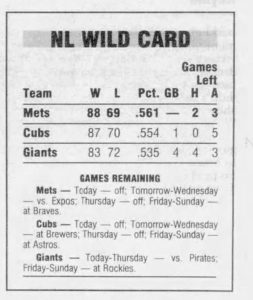 Also, do we have to have two bands of villains shooting down the hopes and dreams? We’d rather there be either the haughty rival from down south that almost never finds a way to lose OR the even haughtier rival from the same city that literally never finds a way to lose. It’s too much to ask to have take on both of them. Very frustrating from an audience perspective. I know we have equity in miracles and all that, but c’mon. Also, do we have to have two bands of villains shooting down the hopes and dreams? We’d rather there be either the haughty rival from down south that almost never finds a way to lose OR the even haughtier rival from the same city that literally never finds a way to lose. It’s too much to ask to have take on both of them. Very frustrating from an audience perspective. I know we have equity in miracles and all that, but c’mon.
Oh, and the wardrobe choice — black? Really? Stop trying to think like a marketer. Leave that to the professionals.
If you’re absorbing anything I’ve said today, you’ve got to work on the ending. And recasting those roles I mentioned. It’s not beyond hope, though. Far from it. If anything, you’re too close to not get this right. Make those changes we discussed, come back next year, and I bet we’ll have a massive hit on our hands.
PREVIOUS ‘MY FAVORITE SEASONS’ INSTALLMENTS
Nos. 55-44: Lousy Seasons, Redeeming Features
Nos. 43-34: Lookin’ for the Lights (That Silver Lining)
Nos. 33-23: In the Middling Years
Nos. 22-21: Affection in Anonymity
No. 20: No Shirt, Sherlock
by Greg Prince on 12 February 2024 2:50 pm Just in time for Pitchers & Catchers, we have broken into the Top 20 portion of MY FAVORITE SEASONS, FROM LEAST FAVORITE TO MOST FAVORITE, 1969-PRESENT. The focus of this entry is neither a pitcher nor a catcher, but he does happen to be somebody who will be reporting to Port St. Lucie in the company of this year’s batterymates in the days ahead. In a happy accident of my not having picked up the pace on this project, this look back through one fan’s lifetime of rooting for teams he didn’t love that much; loved somewhat; loved a whole lot; and, ultimately, loved more than any other is actually kind of timely.
You’ll recognize the modern-day Met in question in about a minute if you haven’t already. Here’s hoping that player’s current contractual situation is resolved to our liking before we are tempted to apply regret to our long-term reading of how we arrived at his professional crossroads. We know we have him at the outset of 2024. We yearn to hear we’ll have him in 2025 and beyond. But no matter what the near future holds, we will always know what we had when we first wrapped our arms around who he was and what he could do for us. I’m certain I will always be glad the wrapping began when it did.
***
20. 2019
In the runup to the 2019 season, new camera-ready general manager Brodie Van Wagenen communicated a lot of things to the media, including, around mid-January, this assessment of the offseason he’d conducted to date:
“We are a good team. We are a complete team, we are a balanced team. We’ve got veterans, we’ve got youth, we’ve got a hunger and desire to win and I look forward to showing people we’re a team to be reckoned with. Let’s not be shy about wanting to be the best, and I fully expect us to be competitive and be a winning team. Our goal is to win a championship and it starts with the division, so come get us.”
The last three words, uttered on the occasion of the Mets signing the cherry on top of Van Wagenen’s winter, former Oakland middle infielder Jed Lowrie, had Freezing Cold Take penciled all over it once the Mets dipped below .500 in early May. “Come get us” might as well have been the team’s and the GM’s epitaph by the All-Star break, a juncture that found the Mets ten games under and holding the second-worst record in the entire league. With any luck, the Mets figured to improve from what they’d been in 2018 (77-85), but were neither the consensus pick nor a “smart money” selection to upend the National League East. “We’re coming for you” would have been a more appropriate tone to strike a year after languishing in fourth place. Hubris was a hairdo that didn’t accent these Mets’ better features.
 
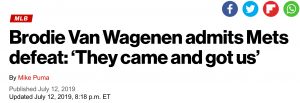
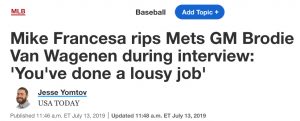
If you shared your thoughts about the Mets with any kind of audience in 2019 and you wanted to score a chagrined grin at the expense of a very handsome man, you reminded everybody reading or listening of the dare Van Wagenen left on the doorsteps of the Braves and the Nationals and how the competition was in the process of responding (the Braves were en route to winning the East and the Nationals would cash in the Wild Card for their first world championship). BVW, as he was destined to be shorthanded in these social media times, knew when foot fit mouth. Ahead of the second half, he admitted to reporters, “They came and got us.”
But Brodie Van Wagenen, as mentioned, said a lot of things ahead of the first Met campaign played on his watch, including three less celebrated sentences just prior to the opening of the 2019 season. Within his tumultuous tenure’s mixed bag of quotations and transactions, perhaps a little more attention needed to be paid to this sentiment:
“I’m not of the mindset that we should be sacrificing the best product for the fans or the best product for the other 24 guys in the clubhouse to save service time or potential future money six years down the road. If Pete Alonso or anybody on our roster is good enough to have six consecutive years without having a hiccup, or without ever having to go to the minor leagues, that’s a good, high-class problem for the player. It’s a high-class problem for the organization.”
Sometimes class tells. Sometimes a GM continually and not unfairly strafed for setting an unrealistic bar knew what he was doing. Sometimes a mixed bag implies there are some tasty morsels included among the dregs.
Rookie first baseman and potentially prodigious slugger Pete Alonso made the Opening Day roster of the 2019 Mets. it was no sure thing. True, their 2018 predecessors were no great shakes; there was no incumbent with a hammerlock on Pete’s position; and the kid had dominated Triple-A pitching. Only in Major League Baseball would that confluence of circumstances not mean a job definitely awaited a young comer. But Pete played baseball. Baseball liked to tell kids who were ready to go in March that they should stick around the minors for a few weeks and cool their heels, lest they accumulate the service time that would make them free agents a year sooner six years from now.
 Yet Pete made the Mets out of Spring Training 2019, circumstances for the offseason that would precede 2025 be damned. Brodie will always rate a gold star for not making Pete or Mets fans wait one minute more. Pete took advantage of his organic start to his first season and blew away whatever hype we’d heard. His first game was Opening Day. His first home run came in the Mets’ fourth game. Twelve games into his major league career, he had six home runs. He ended April with nine. By May, the month I had the privilege of finally witnessing in person one of his Citi Field bombs (No. 16, confirmed fair by replay review), I took it upon myself to start tracking his power progress versus the co-holders of the Met single-season home run recordholders, Todd Hundley (1996) and Carlos Beltran (2006), as well as the fella who, until he was halted by injury, was going to put the record out of reach for a generation, the legendary Dave Kingman in 1976. Yet Pete made the Mets out of Spring Training 2019, circumstances for the offseason that would precede 2025 be damned. Brodie will always rate a gold star for not making Pete or Mets fans wait one minute more. Pete took advantage of his organic start to his first season and blew away whatever hype we’d heard. His first game was Opening Day. His first home run came in the Mets’ fourth game. Twelve games into his major league career, he had six home runs. He ended April with nine. By May, the month I had the privilege of finally witnessing in person one of his Citi Field bombs (No. 16, confirmed fair by replay review), I took it upon myself to start tracking his power progress versus the co-holders of the Met single-season home run recordholders, Todd Hundley (1996) and Carlos Beltran (2006), as well as the fella who, until he was halted by injury, was going to put the record out of reach for a generation, the legendary Dave Kingman in 1976.
I couldn’t go deep on the subject of Met moonshots without thinking about Sky King. Unless a few stray Bicentennial fireworks knocked a couple of his longballs off course, a Mets fan in the summer of ’76 had every reason to believe Kingman was going to place Hack Wilson’s National League standard of 56 home runs in danger. Dave swatted his 32nd home run in the Mets’ 92nd game, a pace four games better than Pete’s 43 years later. Alas, in their 93rd, he messed up a thumb attempting to play defense and would miss too much time to take his hack at Hack. Dave wound down 1976 with 37 home runs, which did establish a new Met record (breaking his own from 1975), but not one you required a telescope to detect. In a way, Pete’s only legitimate competition was eliminated more than three decades before the rookie took his first swing.
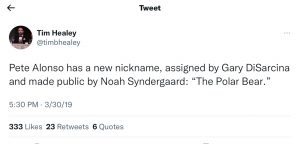 Hundley and Beltran, who finished their big years with 41 home runs apiece, proved modest hurdles for Alonso. Within Pete’s first 50 games, the Polar Bear — an apt and adorable nickname contemporary accounts suggest was crowdsourced by some combination of Todd Frazier, Noah Syndergaard and coach Gary DiSarcina — had gone over fences 17 times. By comparison, Todd required 64 games to hit that many home runs and Carlos needed 60. By the time Pete experienced a brush with a home run drought (no homers between Met Game 103 and Met Game 113), Pete’s cushion separating him from his predecessors was a veritable sofa bolster. The rookie who’d hit the most Met home runs previously, Darryl Strawberry in 1983, likewise couldn’t retroactively keep up. Strawberry, whose 39 homers in 1987 would surpass Kingman’s Met best from eleven years earlier, was promoted to the bigs on May 6 of his first year and put those nearly five months of NL action to very good use, clouting 26 homers and earning Rookie of the Year honors. His 1983 total seemed like such a formidable freshman number for so long, but Pete left Darryl’s initial quantity in the dust before the first half of 2019 was over. In only three months, that line of the Met record book was rewritten. Hundley and Beltran, who finished their big years with 41 home runs apiece, proved modest hurdles for Alonso. Within Pete’s first 50 games, the Polar Bear — an apt and adorable nickname contemporary accounts suggest was crowdsourced by some combination of Todd Frazier, Noah Syndergaard and coach Gary DiSarcina — had gone over fences 17 times. By comparison, Todd required 64 games to hit that many home runs and Carlos needed 60. By the time Pete experienced a brush with a home run drought (no homers between Met Game 103 and Met Game 113), Pete’s cushion separating him from his predecessors was a veritable sofa bolster. The rookie who’d hit the most Met home runs previously, Darryl Strawberry in 1983, likewise couldn’t retroactively keep up. Strawberry, whose 39 homers in 1987 would surpass Kingman’s Met best from eleven years earlier, was promoted to the bigs on May 6 of his first year and put those nearly five months of NL action to very good use, clouting 26 homers and earning Rookie of the Year honors. His 1983 total seemed like such a formidable freshman number for so long, but Pete left Darryl’s initial quantity in the dust before the first half of 2019 was over. In only three months, that line of the Met record book was rewritten.
Pete was running roughshod over modern-day pitching, and franchise history couldn’t keep up with him, either. As 2019 went on, it was clear Pete Alonso was doing things in terms of home runs no Met had done before. It was just as clear to me that I was never as thrilled by any individual Met’s pursuit of any type of benchmark, record or title as I was by Pete’s. The thrill transcended mere statistics because, despite the skies over Shea and Citi having been effectively pierced by the likes of Kingman, Strawberry, Hundley and Beltran, this simply wasn’t an outfit defined by balls it put over walls.
When it came to four-baggers, we’d always ordered our most dramatic and memorable à la carte.
• Willie Mays coming home to the city that never didn’t consider him its own, May 14, 1972.
• Steve Henderson making Magic real, June 14, 1980.
• Gary Carter trying on orange and blue and demonstrating how well it fit, April 9, 1985.
• Mike Piazza when nobody knew what to expect other than Mike Piazza doing something dramatic and memorable, September 21, 2001.
• Wilmer Flores absolutely not getting traded, July 31, 2015.
Donn Clendenon in the World Series. Al Weis in the World Series. Lenny Dykstra and Benny Agbayani to end playoff games. Todd Pratt to end a playoff round. Lee Mazzilli late one All-Star night. Throw in Tommie Agee and Curtis Granderson from the leadoff spot; Yoenis Cespedes and his enormous spurt; Howard Johnson going on rolls; Lucas Duda, too. Circle back to Piazza, the Ginger Rogers of power hitters. He hit them far, he hit them often, and he hit them while half the time doing the baseball equivalent of backwards and in high heels. Mike crouched, called games and looked out at the field as only the catcher does.
Yet even Mike Piazza with his flair for the dramatic and memorable didn’t make home runs the main course of the Met menu. It was like we were on a restricted diet. When we were good, we were about pitching, glovework and fairy dust. What should be our most famous not to mention dramatic and memorable postseason home run went into the books as a grand slam single. Pratt tackled Robin Ventura before Robin Ventura could touch second let alone home. No thanks, Tank seemed to tell his teammate amid the delirium of October 17, 1999, we can’t eat another bite. It’s still dramatic and memorable, but it’s missing more than 180 feet worth of calories.
Another third baseman, David Wright, should have been, per the terms of his contract and the arc of the healthy segment of his career, extending his all-time franchise home run record in 2019. Except he stepped aside for good in 2018, having been sidelined for all but a couple of games that year and completely out of action the year before that and most of the two years before that. Wright, a steady rather than spectacular slugger, completed his Met clouting at 242 home runs, ten shy of Strawberry’s 252. Strawberry’s 252 were like Hundley’s and Beltran’s 41. Really, really good when you stopped and thought about it, but once you realized what home run figures other franchises had inked into their annals, not exactly super.
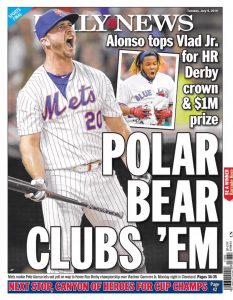 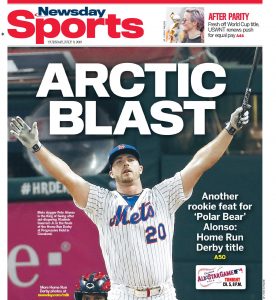 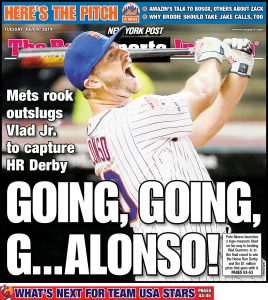 Then along comes the Polar Bear, almost unstoppable in the home run category practically from Day One, definitely in Year One, giving us permission to gorge. Somehow something that Pete made mundane qualified as an event. Another Apple-raiser for Alonso! In another era, crowds would have gathered in Times Square to learn of his exploits from the news racing around the zipper, the town, the nation, the world to keep up with the newly crowned Home Run Derby champ. His 30th! His 40th! His 41st to tie the Met record! His 42nd to break it! His blitz through the forties and, ohmigod, his 50th! A Met hit 50 home runs! Then a 51st! A 52nd, tying the all-time rookie record with two games left! And, in the season’s penultimate game, Pete Alonso of the New York Mets hit his 53rd home run, more than any rookie ever, more than anybody in Major League Baseball in 2019. He was already fewer than 200 from Strawberry’s Met career mark and he’d played precisely one season. Then along comes the Polar Bear, almost unstoppable in the home run category practically from Day One, definitely in Year One, giving us permission to gorge. Somehow something that Pete made mundane qualified as an event. Another Apple-raiser for Alonso! In another era, crowds would have gathered in Times Square to learn of his exploits from the news racing around the zipper, the town, the nation, the world to keep up with the newly crowned Home Run Derby champ. His 30th! His 40th! His 41st to tie the Met record! His 42nd to break it! His blitz through the forties and, ohmigod, his 50th! A Met hit 50 home runs! Then a 51st! A 52nd, tying the all-time rookie record with two games left! And, in the season’s penultimate game, Pete Alonso of the New York Mets hit his 53rd home run, more than any rookie ever, more than anybody in Major League Baseball in 2019. He was already fewer than 200 from Strawberry’s Met career mark and he’d played precisely one season.
WOW!!!!
Yet one player does not make a season. I base this assertion on having lived through Pete’s very exciting power show when it served as counterpoint to the way the Mets were going as a whole, and I gotta say, what the Mets besides Alonso (along with that Jacob deGrom fellow on his way to another Cy Young) were giving us wasn’t much of a 2019.
Until it was. That took everybody’s contribution. Suddenly, in late July, right around the moment Pete matched Frank Thomas’s original single-season Met home run record of 34, the hat was being passed incredibly effectively. From Jeff McNeil to Michael Conforto to J.D. Davis to Amed Rosario to Wilson Ramos until it reached Dom Smith in the eleventh inning of the season’s final game. Every Met was kicking in a little, then a lot. The team Van Wagenen constructed was living up to the GM’s chest-puffing at last.
Pete hitting a ton of home runs while the Mets stumbled to a 40-51 start: plenty fun when he batted, not much fun otherwise.
Pete hitting a ton of home runs while the Mets racked up a 46-25 finish: baseball like it oughta be.
The 86-76 Mets didn’t assume the guise of a contender until it was a tad too late to dent the playoff race in earnest. Ah, but we didn’t fully know that until we claimed hindsight on irrevocable waivers. We sensed it repeatedly in late August and early September and mid-September, the way you do when you know deep down you’re bound to fall a little short, yet every time we were ready to throw in the towel, the linen would not leave our hand. Our Mets had gotten good enough all at once to let us believe, and that’s always dangerous when we’re determined to be realists. When it was finally too late to any longer deny the inevitable, after a one-run loss in Cincinnati during the season’s second-to-last weekend stuck the club 4½ out of the final playoff spot with eight to play, Todd Frazier tried like hell to work the long mathematical odds in the Mets’ favor. “I felt like we had to go 9-1” down the stretch, the Toddfather reasoned. “Here’s our one.” I knew desperation was talking and didn’t invest much hope in Frazier’s calculation. They were indeed ousted from the race a few days hence.
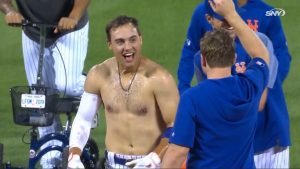
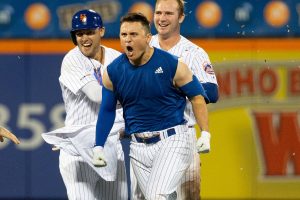
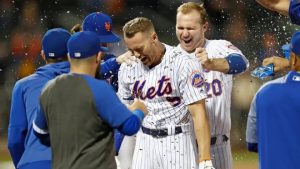
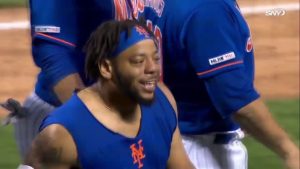 Still, Todd from Toms River wasn’t necessarily talking crazy. He was part of a team that between July 25 and August 10 went 15-1 and completely changed the tenor of their season. From a unit that was mainly about Pete Alonso hitting home runs, they evolved into a unit that was all about winning games, contending for a Wild Card and having a blast while trying to pick up ground. The veterans, the youth, the hunger and desire to win that Brodie Van Wagenen promised in January were all in evidence. It was during the 15-1 stretch that they started pulling off the jersey of the given evening’s hero to celebrate walkoff wins; that players not named Pete Alonso began getting our attention for Amazin’ feats; that LFGM became an accepted spelling for Let’s Go Mets; and that anything began to seem possible. It didn’t propel the 2019 Mets to come get a playoff spot when it seemed like they had a real chance, but it was enough to transform a season that had been a veritable one-man show into the kind of team effort that keeps a fan tuning in out of anticipation rather than habit. Still, Todd from Toms River wasn’t necessarily talking crazy. He was part of a team that between July 25 and August 10 went 15-1 and completely changed the tenor of their season. From a unit that was mainly about Pete Alonso hitting home runs, they evolved into a unit that was all about winning games, contending for a Wild Card and having a blast while trying to pick up ground. The veterans, the youth, the hunger and desire to win that Brodie Van Wagenen promised in January were all in evidence. It was during the 15-1 stretch that they started pulling off the jersey of the given evening’s hero to celebrate walkoff wins; that players not named Pete Alonso began getting our attention for Amazin’ feats; that LFGM became an accepted spelling for Let’s Go Mets; and that anything began to seem possible. It didn’t propel the 2019 Mets to come get a playoff spot when it seemed like they had a real chance, but it was enough to transform a season that had been a veritable one-man show into the kind of team effort that keeps a fan tuning in out of anticipation rather than habit.
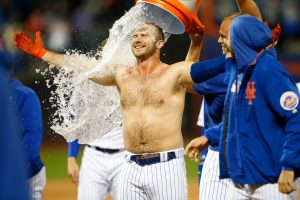
Moral: tracking a ballclub’s collective success beats tracking that of one individual, no matter how powerful the Polar Bear in the spotlight.
PREVIOUS ‘MY FAVORITE SEASONS’ INSTALLMENTS
Nos. 55-44: Lousy Seasons, Redeeming Features
Nos. 43-34: Lookin’ for the Lights (That Silver Lining)
Nos. 33-23: In the Middling Years
Nos. 22-21: Affection in Anonymity
by Greg Prince on 4 February 2024 1:48 pm En route from the bottom 60% of MY FAVORITE SEASONS, FROM LEAST FAVORITE TO MOST FAVORITE, 1969-PRESENT — Nos. 55–44 here; Nos. 43–34 here; Nos. 33–23 here — to the just plain Top 20 (expressed without a percentage sign because they are, in fact, Nos. 20–1), I need to make a stop in consecutive years to explore No. 22 and No. 21 on my list. It’s a convenient coupling and can’t possibly be coincidental, but I’m pretty sure the adjacent nature of these seasons in my ranking of favorites is just that.
The two seasons we are about to visit do exist adjacently in both my affections and their chronology. They are bound together by one ginormous event that was a huge factor in our baseball lives for 232 days. It (along with winter, one supposes) was the reason there was no baseball in that span. Then the ginormous event was over and receded into the backstory of our game, though not as far back as the two Met seasons it linked. These seasons are utterly anonymous in any garden-variety retelling of Met history, which may be just as well since they happened almost off the narrative grid that’s taken us from 1962 to the present. In their limited time as the present, both years were about new beginnings. The first of them didn’t take in such a capacity — that aforementioned ginormous event cut if off before it could gain traction; at least it stanched the bleeding of the season that preceded it. The second of them hinted at what was ahead, but doesn’t quite fit the role of harbinger of an era to come. A little here and there, perhaps, but it, too, doesn’t connect neatly to its relatively near future.
Yet here they are, on the edge of the Top 20, ranked above 33 of the Met seasons through which I have lived and rooted. I have maintained above-average affection for these two years despite their anonymity, or maybe as an ode to it. I know I lived them. I know I rooted during them. I remember ripples of gratification obscuring these seasons’ obvious imperfections. I liked these years a good deal then. To say I treasure them now might be an exaggeration, but I’m guessing they’ve stayed closer to my Met heart than they’ve hung around the Met heart of others. That’s just where I’ve kept them since I first found them roughly three decades ago, and it’s never occurred to me to shove them all the way into the back of my memory’s storage unit.
Keep the seasons nobody else thinks about handy. You never know when you’ll need them.
***22. 1994
No World Series in 1994? The hell you say! I experienced my version of the Fall Classic throughout the spring and as much summer as the feuding factions of MLB would allow. My World Series pitted the Mets versus how bad the Mets could have been. Respectability captured the only Series that mattered in 113 games. Context was named MVP.
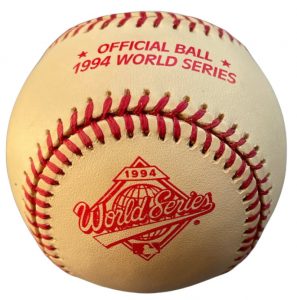 True, there was no actual World Series that year. I prefer to err on the side of “big whoop” where that widely bemoaned cancellation is concerned. When Commissioner Bud Selig announced more than a month after the Players Association struck Major League Baseball that the World Series was canceled, garments were rent and wails went up. Millionaires and billionaires arguing!!! How could they do this to the WORLD SERIES?!?! I’ll never watch another game!!! I was approximately 5% sympathetic, 95% STFU with that BS, except I probably didn’t use acronyms. True, there was no actual World Series that year. I prefer to err on the side of “big whoop” where that widely bemoaned cancellation is concerned. When Commissioner Bud Selig announced more than a month after the Players Association struck Major League Baseball that the World Series was canceled, garments were rent and wails went up. Millionaires and billionaires arguing!!! How could they do this to the WORLD SERIES?!?! I’ll never watch another game!!! I was approximately 5% sympathetic, 95% STFU with that BS, except I probably didn’t use acronyms.
Yes, the World Series oughta be sacrosanct, but no more so than the regular season that sets its stage, which in 1994 had a curtain pulled down over it on August 11 after negotiations regarding a salary cap the owners wished to impose went nowhere. If you couldn’t get back to your schedule and play it to some sort of conclusion, why would a World Series matter? I start to care about the World Series in an earnest, nonpartisan way once the identity of the pennant-winners comes into focus. We were miles from those big reveals on August 11.
None of this had a darn thing to do with the Mets in 1994, which may also be why the World Series talk rang hollow with this diehard baseball fan. On the last night games were played, the Mets sat 12½ games from a postseason berth, the first time one was compelled to apply such nomenclature to baseball. Before 1994, we’d simply state how many games out of first place a team that wasn’t in first place was, and you had all you needed to know. But now, like every other sport, baseball offered side doors to the playoffs. The Wild Card was brand new in ’94, one per league. The Mets weren’t in the running for one of those. Nor, at 18½ games from the top of the NL East, was first place realistically attainable to them in their realigned division. The Expos were on fire and the defending Western Division champion Braves never lost a step when somebody finally decided to get geographically correct about their Georgia location. Let Expos fans and Braves fans and other teams’ fans regret the lack of a 1994 World Series. It wasn’t our problem. I was the prototype for football coach Jim Mora bellowing at the assembled Indianapolis media, “PLAYOFFS?” when a reporter dared ask him if his 4-6 Colts still had a shot at playing for the Super Bowl.
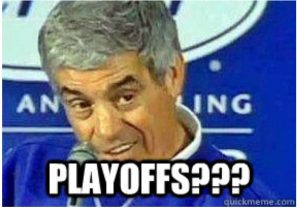
Yet I didn’t get mad that the Mets had no chance at any canceled playoffs, because the 1994 Mets were getting close to getting even in the winning percentage column. They succeeded wildly at not sucking all that much. T-shirts weren’t licensed and sold at Modell’s to celebrate the accomplishment, but I guarantee you if they had been, I’d have bought one. Not automatically expecting to lose can move theoretical merchandise.
The Mets’ record of 55-58 is a little misleading in communicating a sense of their ability to sustain stretches of competent baseball. They were surprisingly good in the first and final swaths of their limited season (18-14, 22-15), a stone drag in the ad hoc middle (15-29). Their composite mark left them four wins shy of their 59-victory sum from 1993, which, it should be noted, was compiled across a slate of 162 mostly miserable games. There’s that most valuable context coming to the fore: it was no longer 1993 for the Mets. That year’s team was a grim laughingstock. If it’s darkest before the dawn, 1994 represented those five or ten minutes ahead of the time listed for sunrise. It was no longer pitch black outside. You could begin to see clearly now.
Had there been no strike and the Mets maintained their .487 winning percentage — sixth-best in the entire National League — that would have been good for 79 wins, a gain of twenty from 1993, not to mention a couple of lucky bounces from being a winning team one year removed from being the butt of David Letterman’s monologue. Had they reverted to the low expectations 1993 wrought, they were still highly unlikely to lose as many as 90 games. The Daily News ran a computerized simulation of the daily standings during the strike in lieu of the real thing. According to Bill Konigsberg and Pursue the Pennant, the 1994 Mets “would” have gone 73-89. Not great, but a legit hop, skip and/or jump from the 59-103 that weighed us down in ’93.
I keep coming back to 1993 even as I praise 1994 for getting us away from it. Perhaps I was prone more than I realized to a condition we’ll label Marlin Envy. Yeech, I know, but Florida was a fresh new team in 1993. Colorado, too. I’d never experienced National League expansion from the ground up. Ballparks you hadn’t seen before. Logos you hadn’t seen before. Names from out of nowhere that lodged themselves onto the schedule and into your consciousness. Teal! Purple! The novelty was bracing. What was less delightful was being the one established unit in the senior circuit incapable of taking advantage of the neophytes. We finished behind the Marlins in 1993. We finished behind the Rockies in 1993. We finished behind everybody in 1993.
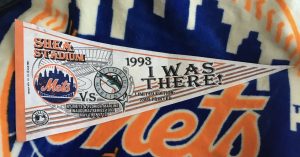
If you can’t beat ’em, sort of replicate ’em. The 1994 Mets came off a bit like a modern expansion outfit themselves. Not in line with the 1962 version of themselves, but the way expansion teams were constructed in the ’90s, with a handful of high-priced players mixed in with the prevailing gumbo of discards and kids getting a chance they might not have arisen had these extra jobs not been open. The team charter flew by the seat of its pants. Opening Day was April 4. Our Opening Day first baseman, David Segui, was acquired on March 27. Our Opening Day shortstop, Jose Vizcaino, joined the organization on March 30. The first week of the season included the Met debuts of seven other players guaranteed to set few fans’ hearts aflutter. Unheralded rookies Fernando Viña and Kelly Stinnett. Downswing retreads Pete Smith and John Cangelosi. Scrap heapsters Jonathan Hurst, Doug Linton and Luis Rivera. Yet with these and the rest of the Mets off and running to a start of 4-1, who gave a damn about their non-reputation? If we knew the term “replacement level,” we would have embraced it. All we wanted was to replace the bitter taste of 1993.
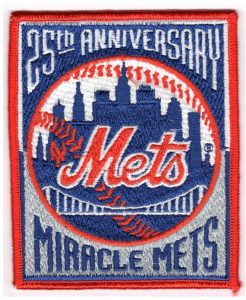 Of the 37 players who wore the Miracle Mets 25th anniversary sleeve patch in 1994 (you don’t have to be a uniform sleuth to pick out ’94 highlights), only four — Dwight Gooden, Kevin McReynolds, John Franco and Todd Hundley — had previously played for a Mets team that had posted a winning record, something no Mets team had done since 1990. If we were moving on from 1993, we were also inextricably separated from the suddenly not so recent golden age of Mets baseball. Gooden was the last 1986er extant on the roster. 1988’s near-MVP McReynolds returned after a two-year absence, Kansas City offloading him on us so we could dump Vince Coleman on them. K-Mac wouldn’t be back after 1994. Doc, testing positive like it was 1987, wouldn’t last until the strike. When the 1969 Mets were introduced at a distressingly empty Shea Stadium on July 24 (nothing personal, fellas — Mets attendance landed near the bottom of the NL), they were the only world champions in sight. Of the 37 players who wore the Miracle Mets 25th anniversary sleeve patch in 1994 (you don’t have to be a uniform sleuth to pick out ’94 highlights), only four — Dwight Gooden, Kevin McReynolds, John Franco and Todd Hundley — had previously played for a Mets team that had posted a winning record, something no Mets team had done since 1990. If we were moving on from 1993, we were also inextricably separated from the suddenly not so recent golden age of Mets baseball. Gooden was the last 1986er extant on the roster. 1988’s near-MVP McReynolds returned after a two-year absence, Kansas City offloading him on us so we could dump Vince Coleman on them. K-Mac wouldn’t be back after 1994. Doc, testing positive like it was 1987, wouldn’t last until the strike. When the 1969 Mets were introduced at a distressingly empty Shea Stadium on July 24 (nothing personal, fellas — Mets attendance landed near the bottom of the NL), they were the only world champions in sight.
Maybe the most compelling evidence that time was marching on came from the box score of April 5, the season’s second game. Dallas Green, in what was supposed to be his first full season of getting the Mets back on their feet, used a dozen players to beat the Cubs that afternoon. None of the twelve was alive on April 11, 1962, the official date of birth for Casey Stengel’s baby Mets. Our actual expansion roots, just like our glory days, were also growing more and more distant.
In a way, the 1994 Mets, commemorative patch notwithstanding, were, for better or worse, unmoored from their past. It was probably a necessary detachment. The Mets’ past was no longer providing a useful template for their immediate future. Their nascent present was about to evaporate on August 11, anyway. Nineteen players who were Mets in 1994 wouldn’t be Mets in 1995. Some of that was the attrition of a long strike, some of it a fact of replacement level life. For those of us just learning to communicate via computer, the phrase “reboot” was entering our lexicon. Perhaps that’s what we were experiencing as Mets fans back then. Our screen froze in 1993. Somebody must have told us to unplug, then plug back in and see if it works.
Son of a gun, it did. But maybe someone from IT needed to come by and take a closer look to figure out what exactly was going on.
21. 1995
Had the power rankings contrivance existed in 1995, the Mets might have crept to the fringe of the middle of the pack by the end of the season, decently above the cellar-dwelling rabble, far beneath your momentum-laden outfits like the Refuse to Lose Mariners and your eventual World Series combatants Atlanta and Cleveland. But that was no way to measure what we who were paying attention to our Amazins had goin’ on. Comparing the Mets to the powerhouses of the day wouldn’t have reflected the velocity with which our mood had risen. Had we worn mood rings, you would have seen ours turning violet, the color indicating the ring in question wraps around the finger of a person feeling very happy.
 Mood rings weren’t undergoing a renaissance in the early fall of 1995, but the Mets sure were, a stark reversal from where they started in baseball’s late spring. The all-encompassing strike that knocked out everything the previous August through October crossed the line from one year to the next as 1994 became 1995. We didn’t know when our game would be played again, and we didn’t know who would play it. The owners, unable to pierce the resolve of the Players Association, hatched a scheme to hire replacement players. Not replacement level players (the Mets had already tried that in ’94), but minor leaguers not subject to union rules; stray retirees who thought they had something left; and, essentially, some dudes off the street. If you put them in major league uniforms and told the fans that these fellas were now your favorite players, maybe it fool some of the people some of the time. Mood rings weren’t undergoing a renaissance in the early fall of 1995, but the Mets sure were, a stark reversal from where they started in baseball’s late spring. The all-encompassing strike that knocked out everything the previous August through October crossed the line from one year to the next as 1994 became 1995. We didn’t know when our game would be played again, and we didn’t know who would play it. The owners, unable to pierce the resolve of the Players Association, hatched a scheme to hire replacement players. Not replacement level players (the Mets had already tried that in ’94), but minor leaguers not subject to union rules; stray retirees who thought they had something left; and, essentially, some dudes off the street. If you put them in major league uniforms and told the fans that these fellas were now your favorite players, maybe it fool some of the people some of the time.
Thanks to a U.S. District Court judge named Sonia Sotomayor, we never discovered just how gullible we might be. Sotomayor issued an injunction against the owners on the eve of Fauxpening Day, keeping them from unilaterally subverting the collective bargaining tenets that had been in place before the strike. In short, play ball!
Alas, the Mets weren’t prepared to do so, or at least not do it well. On April 26, after an abbreviated Spring Training, they lost their first game, the first game ever played at Coors Field in Denver. On April 27, they lost the second game ever played at Coors Field in Denver. For the first time since 1965, the Mets were 0-2. Two home wins followed (disgruntled fans tossed money at the players in the Shea Opener), boosting the 1995 Mets to .500 for the first and last time.
The season would be shortened to 144 games in deference to the late start. Yet the season started getting long real soon. That’ll happen when your team drifts from .500. For a spell, it wasn’t bothersome. Just having baseball back was a thrill, as it is every April. That never lasts, though. Any baseball might beat no baseball, but bad baseball drops out of contention quickly enough.
For the fifth consecutive season, the Mets were wearing home jerseys that didn’t look quite like the jerseys they wore the year before, their search for an identity taking a sartorial twist. In 1991, they’d added buttons to their racing stripe tops. In 1992, there was an “S” patch to honor the late Bill Shea. The 1993 strategy deleted those ’80s side stripes and birthed the wordmark tail nobody asked for; it was still there in 1994, as were, for just that year, MLB’s 125th Anniversary logo on one sleeve and a quarter-century commemorative emblem for the 1969 Mets on the other. In 1995, the Mets’ motif was back to basics…maybe a little too basic. The tail was off the “Mets,” which was a good deletion, and the overall look echoed what you might call the classic motif of 1965 to 1977. Mets in script, number on the front, no muss, no fuss, not bad.
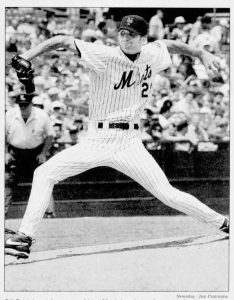
Except there was something about that script “Mets” that struck this viewer as a little too thin, definitely not as hearty as it used to be. It seemed to speak for what the 1995 Mets — who we weren’t even sure were going to be the 1995 Mets when replacement players roamed St. Lucie — thought of themselves.
We don’t want to bother anybody.
We don’t want to get in the way.
Maybe you’ll come out and join us at the ballpark.
Maybe you won’t.
You might not know who all of us are yet, but that’s OK.
Just look for the familiar name on the front.
Whatever you want to do is fine with us.
We still have a hundred-something games left.
We’ll be here even if you’re not.
A fan will see what a fan sees. For quite a while in 1995, I saw an invisible team. When the Mets did appear in a highlight, it was as backdrop for some other team’s development. The Rockies’ new ballpark. Cliff Floyd of the Expos badly banging up his wrist in a first base collision with Todd Hundley. Chipper Jones of the Braves belting his first career home run into the sparsely populated right field Loge seats at Shea. There was minimal carryover from whatever infused with 1994 with hope before the strike. My main Met coming into the season, Rico Brogna, had won me over as a rookie the summer before when he emerged from what seemed like nowhere to bat .351 in 39 games. I waited out the labor-management machinations without rancor because I knew Rico Brogna was waiting on the other side. In the chill of Denver on Opening Night, Rico batted third and blasted the first home run in Coors Field history in the fourth. The Mets lost in fourteen. Rico’s start sizzled like it had in ’94, then cooled off to solid if not spectacular, which describes the injury-abbreviated career that awaited him. I sort of believed he’d keep hitting .351, just as I definitely believed the Mets who finished just shy of .500 in 1994 would storm past the respectability barrier after Judge Sotomayor gaveled some common sense into the National Pastime.
Solid if not spectacular would have been fantastic for the 1995 Mets at mid-season. The All-Star break came 69 games in, a function of the shortened season. The Mets were buried at 25-44, the third-worst record in all of baseball. Our only All-Star was Bobby Bonilla, whose persona had ventured into elder statesman territory, except for that May Saturday in Philadelphia when he a) ran through third base coach Mike Cubbage’s stop sign, b) got thrown out at third to kill a Met rally, and c) insisted to reporters that Cubbage “can kiss my ass” once told mild-mannered Mike’s side of the story (“I held him up”). Otherwise, Bonilla was being productive at the plate and less destructive than in past seasons to the club’s esprit de corps. Four years into his five-year contract, that’s really all you could ask of Bobby Bo. Still, you prefer to beam with pride rather than grimace in resignation when the lone player representing your cause in a going-nowhere year is introduced at the All-Star Game.
Two genuine spritzes of excitement, delivered a month apart, did burst forth from the rotating lawn sprinkler of player transactions. We didn’t even mind if our trouser legs got soaked as we strolled down the street when the news hit us. On June 17, Bill Pulsipher, 21, was summoned to make his major league debut. Pulsipher — Pulse — was the lefty starter we’d been hearing about since the year before when he was dominating Double-A. On July 17, Jason Isringhausen, 22, got the call to throw his first pitches in the bigs. Isringhausen — Izzy — was Pulse’s righty complement and the object of a swelling fan outcry to get him up here already from Norfolk, where he’d been toying with Triple-A batters. Each pitcher went seven innings in his respective introduction. Pulse’s, at Shea, were messy and the Mets lost (I witnessed it in person alongside this Jason guy I knew only from an AOL board; how exotic!). Izzy’s, at Wrigley, sparkled and the Mets won (I listened to most of it on the radio because something called The Baseball Network couldn’t be bothered to beam it into New York). For fourteen combined innings, our mood rings escaped black. For fourteen combined innings, the kids allowed us to anticipate what might be.
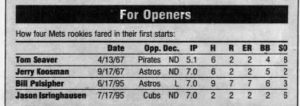
What actually was by the drizzly Sunday morning of August 6 had reverted to dreary, as the New York Mets sported the worst record in the National League, 35-57. The trade deadline motivated them to send Bobby Bo to Baltimore and Bret Saberhagen to Colorado. In a couple of weeks, they’d end the Brett Butler experiment and dispatch their leadoff hitter back to Los Angeles from whence he came. Izzy and Pulse were the bleeding edge of a de facto youth movement. The Mets didn’t explicitly advertise their change in direction. Nobody implored us to bring our kids to see their kids, “their” kids dressed in those not quite satisfying thin-scripted jerseys, yet that’s what I was doing on August 6. Well, no kiddies, but I did bring my wife, both of us in box seats alongside my college friend Rob Costa, by 1995 a sales rep in good standing for what would eventually be reviled as Big Pharma. Rob was a sweetheart who didn’t much care about baseball, but tickets to Mets games were one of the perks he was authorized to disperse at his discretion. He made us his clients for the afternoon.
I’d been to six games since the strike ended. The Mets were 0-6 when I appeared in their midst. On August 6, there was mist, but there was also no mistaking that a losing streak was about to be broken. Third-year starter Bobby Jones gave up a first-inning run to the Marlins when Terry Pendleton grounded out to second with a runner on third and less than two out. Pendleton was a ghost of Shea pennant race past. Gloomy as the skies were, this was no day for ghosts or, for that matter, the past. Jones settled in to keep the Fish at bay through six. In the meantime, Bobby from Fresno drove in the tying run on a squeeze bunt in the second; my main Met Rico went deep to provide us a lead in the fifth; erstwhile utility infielder Edgardo Alfonzo, lately getting a chance to wrangle third base with Bonilla no longer around, chipped in an RBI in the sixth; and Jeff Kent, who never seemed to shake the boos his crummy first two months brought on, put things out of reach with a three-run homer. Jones pitched into the seventh of a 7-3 Met victory, my first since May 1, 1994.
Jones was 25, same age as Brogna. Alfonzo, or “Fonzie,” was all of 21. Kent was the senior youth at 27. Throw in Pulse, Izzy, 26-year-old Hundley behind the plate most days, 24-year-old Carl Everett around in right, maybe 25-year-old left fielder Damon Buford, who we got for Bonilla…did we have something here? Minor league slugger Butch Huskey would be promoted a couple of weeks later. He was 23. The other Oriole we received as payment for Bobby Bo, Alex Ochoa, would be up in September. “Five-tool” was the scouting report attached to this intriguing 23-year-old.
We had something here, all right. We had a young Mets team finding its footing all at once. From that gray Sunday afternoon at Shea in the company of Rob Costa forward, all the way to the end of the season, the Mets played 52 games and won 34 of them, an eight-week pace three games better than anybody else in the National League over that span and, for what it was worth, one game better than the 1986 Mets (33-19) from when they played their final 52 regular-season games. Meanwhile, Saberhagen and Butler were helping the teams to whom they’d been traded to the expanded playoffs, the same tournament that would include Worst Team Money Could Buy alumni Eddie Murray with the Tribe and Vince Coleman with the M’s. Bonilla didn’t show Baltimore October, but he won terrific-teammate kudos for pushing modest Cal Ripken from the dugout to take a victory lap at Camden Yards when Cal surpassed Lou Gehrig’s consecutive games played standard on September 6.
What was that acronym I learned from America Online? “LOL,” which by the 2010s would often be something done in the Mets’ faces when players they moved on from moved on themselves to bigger things and better situations. Yet we didn’t miss any of those veterans who wore out their Shea welcomes. We had the kids, and this old man of then 32 was bringing himself as often as possible to see them in winning action. My 0-6 start became a 7-7 final personal record, a crisp .500 in my steno pad of dutifully logged results, secured on the last day of the season when nothing could have deterred my rushing to Flushing. It took eleven innings, but the Mets beat the Braves for a series sweep. They had just swept the Reds the series prior. In August, they had swept the Dodgers, Izzy outpitching reigning rookie phenom Hideo Nomo in a sunny Sunday finale. The Braves, Reds and Dodgers were the three National League division winners in 1995. DiamondVision let us know the Mets were the only NL team to take three of three from all three flag-bearers. We were creeping into the highlights on our own merit.
The Mets’ final record in that 144-game season was 69-75. Momentum might have carried them to 81 or more wins had the pocket schedule contained its usual allotment of boxes. The upsurge was enough to catapult the Mets from fifth/last place in the East to a tie for (admittedly distant) second. We were statistically better than Florida, better than Montreal and no worse than Philadelphia, the league’s most recent pennant-winner. Give us time and we could think about taking aim at Atlanta.
I’ve rarely ended a Met year in a better mood, even if there was no ring to prove it.

by Greg Prince on 26 January 2024 4:01 pm “Yeah!”
“All right!”
“Finally!”
I can’t quote exactly, but the words above were more or less my reactions to immortality stamping its approval on the permanent records of Met icons and elevating them to the highest level visible to the general baseball public. We already knew our guys —
Tom Seaver, before posting the magic 98.84% no other starting pitcher has ever matched, in ’92;
Bob Murphy, before the Frick picked up on what he’d been saying into his mic all those summer nights, in ’94;
Gary Carter, before it could be discerned that an institutional choice between bronze logos would be necessary, in ’03;
Mike Piazza, before a fourth go-round certified him as “durable,” “prolific” and “power-hitting”, in ’16;
and Gil Hodges, after multiple generations had failed to recognize what he did and who he was, until all was remedied and forgiven in December of ’21
— were greats. Now nobody else had an excuse to not know. Our guys were Hall of Famers.
A check mark on at least 75% of Baseball Writers Association of America ballots will usher a player into the Hall of Fame. On Tuesday night, David Wright was revealed to have received 6.2% of the BBWAA vote, and I pumped a fist. I think I added a “Yeah!” despite the voting not being all Wright. It didn’t get him into the Hall à la 2024 electees Adrian Beltre, Todd Helton and Joe Mauer, and it didn’t get him within conceivable plaque gallery reach like his teammates Billy Wagner (73.8% with a year left) and Carlos Beltran (57.1% and the echo of banging trash cans fading), but it kept him in the conversation. Sometimes you can’t ask for more than to be talked about a little.
When David was in his prime, which lasted about a decade, I wondered how his Hall of Fame case might unfold. I was entitled to Mets fan bias, yet I wasn’t sure I’d be shouting to the heavens that an injustice was being done if he wasn’t collecting scads of ticked boxes when his time under the microscope came. It’s like that when you live with a player day in and day out.
David made outs slightly more than seven of every ten at-bats.
Why couldn’t have David gotten a hit there?
David was known to once in a while throw around or beneath the grasp of his first baseman.
Geez, David, c’mon!
David couldn’t lift an entire his team on his shoulders when that team insisted on weighing itself down with underachievement.
I’m mad at all of them — yes, even David.
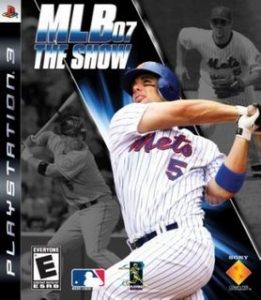 He never put up video game numbers, but he was always the real deal. He did everything well and conducted himself better than that, still I never convinced myself he was quite on the level of a Schmidt, a Brett, a Chipper Jones, if you’ll pardon the expression. Those, to me, were Hall of Fame third basemen. I imagined some clever analytic argument would be floated on his behalf, and I could picture groupthink developing in the same way it’s evolved for players it never occurred to me were Hall of Famers when I experienced them when I watched them actually play, and, my Mets fan bias notwithstanding, I figured I’d kind of roll my eyes at the whole exercise. He’s not Mike Schmidt. He’s David Wright.
Then David’s prime screeched to an injury-riddled halt and I stopped wondering about his Hall of Fame case until the Hall of Fame released a ballot that included his name, and my prevailing Hall of Fame desire became 5 for 5: get those 5% of the votes that would keep the last Met who will ever wear 5 alive in the greater baseball consciousness for another year. Don’t let him be one and done. Don’t tell me the career of the only long-term everyday player who played every day as a Met until he physically couldn’t and never played in any other garb (besides that of Team USA) didn’t at least hint at that level. Don’t tell me nobody besides us noticed our guy, our Captain.
My desire was satisfied by a margin of four votes. Yeah. All right. Had five writers who threw him a check mark not thought highly of David’s stats or comps, or remembered warmly he was what he was as a third baseman/run producer while also being the standup guy they needed whenever they needed an honest quote, he’d be off next year’s ballot. Hanging around in the “all other” discussion every December and January carries its own burden of limited expectation and likely disappointment, but from the outside looking in, it seems preferable to being told to take your Silver Sluggers, your Gold Gloves, your All-Star selections, your quiet leadership and all the rest of your selfless persona and move along.
Less than 5% for No. 5 would have been the moral equivalent of spinal stenosis. No chance to change minds and garner a touch of momentum winter to winter. No chance to wave Scott Rolen’s name around and reason, Wright’s no Schmidt, but there was this other Philadelphia third baseman to whom he was pretty similar, and if Rolen’s in the Hall, well… No chance to be considered at all unless a Contemporary Era-type committee became intrigued by his case down the road, maybe far down the road, when “contemporary” implied an era way beyond his. No chance that wasn’t random that David Wright would be mentioned by anybody outside the walls of Metsopotamia, where we don’t require anybody else’s stinking validation to tell us who our greats are. Yet it sure is nice to know that slightly more than a bare minimum of professional baseball observers remembered there was once a lifetime Met who was on a path that, had all continued in decent health, could have led to Cooperstown.
by Greg Prince on 22 January 2024 1:00 pm We have reached the third installment of MY FAVORITE SEASONS, FROM LEAST FAVORITE TO MOST FAVORITE, 1969-PRESENT. I can’t swear it’s the middle installment, but below you’ll find the middle portion of the list: the seasons just before the median (Nos. 33-29); the median season (No. 28); and the seasons just beyond the median (Nos. 27-23). As is implied by reaching the center square and adjacent environs, the overall Mets experiences here are veering more toward the explicitly positive than they were at the outset of this journey. Of course if you’re a Mets fan, you understand that even years whose statistical output appears splendid on the surface may not resonate as enchanting when you remember what they were actually like to live through. This explains how seasons with 88 or 92 wins will rank well below seasons with 41 or 68 wins. To be clear, winning beats losing 162 out of 162 times. Nevertheless, there are winning seasons and there are favorite seasons. They don’t always meet in the middle. My desire to say something nice about what I perceive as not altogether nice Met days remains, yet I stowed the kid gloves for certain of these campaigns and let my lingering discontent seep where appropriate. If a season encompassed 88 or 92 wins yet lands in the lower half of a ranking of favorites, I have to think it brought its infamy upon itself.
As in Part One (Nos. 55-44) and Part Two (Nos. 43-34), I have striven to mine my rooting subconscious and share some memories and insights that haven’t come up in these pages before. That gets more challenging as the countdown goes on, given that over the past nineteen years of blogging, I’ve shared a lot, particularly about the seasons I liked and loved most (not to mention the seasons that were in progress between 2005 and 2023). A person has only so much past, even one who goes back as far as I do. If bits and pieces begin to sound familiar to you as a regular reader, first off, thank you for reading regularly, and secondly, I hope my attempt to craft new spins adds a fresh element.
***33. 2007
I don’t know much about gambling per se, but here’s a piece of probably profitable advice: the next time the Mets are coming off a playoff year, bet the under the year after. The Mets have made the postseason ten times. Ten times, the Mets have posted a lesser record the year after; on average, their won-lost mark is minus-13 versus the more satisfying and successful season preceding it. I suspect that’s what the wagering community refers to as a lock. Not that precedent predicts everything, but 2007, when the Mets couldn’t maintain their division-winning pace of 2006, should have taught us once and for all that not only won’t the year after be quite (or nearly) as good, it won’t feel as good. Given a positive trendline, we’ll never stop trying to convince ourselves it feels comparably great — we might even be brimming with confidence as late as the middle of September — but don’t bet it will turn out well either mathematically or experientially.
32. 1987
“You know what it was like?” I remember telling a friend that November. “It was like having a nagging sinus headache all season.” I’ve been forever prone to sinus headaches that almost but don’t completely go away no matter what I take for them. I can operate like a functioning human being if I must, even manage to have some facsimile of fun in the intervals when it seems to recede, but until it’s completely gone, I know something’s off and I find myself pressing an index to the top of the bridge of my nose on whichever side is piercing most. It doesn’t help. What really helps is holding an index finger high in the air like I did the year before 1987.
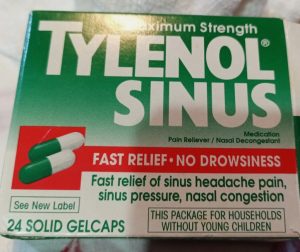
31. 2001
For four-and-a-half months, 2001 provided a template for cruddy 2023. Then, as August grew late, 2001 began to echo 1973. Then the second Tuesday in September happened, which had nothing to do with baseball, yet there were the Mets, resuming their roll when play unpaused the Monday after that Tuesday, on September 17; and coming home to New York on September 21; and Mike Piazza hits a homer; and they win that night, and they win the next night; and they’ve picked up ten games in the standings in a five-week span; and you gotta believe something way bigger than a charge-from-behind pennant race is happening at Shea Stadium. Then, in the shadow of two fallen towers, the Mets find a way to break whatever corners of our heart aren’t already broken not once (Braves 5 Mets 4 in 11 on September 23), but twice (Braves 8 Mets 5 via a walkoff grand slam on September 29). Then, save for Mike’s incandescent swing, the entire season is memory-holed. I’m here to tell you it did happen. It was real and it was almost spectacular.
30. 1978
 On April 23, the back page of the Daily News led its sports coverage with a headline trumpeting the Mets’ capture of the top spot in the National League East, something NOBODY was expecting at the outset of the second year of the Grant’s Tomb era. Staring at it when I was fifteen, my mind worked like Lisa Simpson’s years later when she met a cool kid who paid her hat a compliment. “Scanning for sarcasm…it’s clean!” I liked the headline so much, I clipped it and taped it to the door of my bedroom closet. The News that Sunday wasn’t messing with me. Jack Lang may have been shaking his head while he typed it in the Wrigley Field press box, but his lede was as sincere as it was accurate: “The first place Mets! Roll that around on your tongue for a while and see how it sounds.” Manager Joe Torre affirmed, “It sounds beautiful to me, just beautiful.” The explanation that followed in the wake of the Mets beating the Cubs was just as mellifluous: “The victory, combined with the Expos’ sweep of the Phillies in a twinbill, gave the Mets first place all by themselves.” Cripes, Lang even referred to Mardie Cornejo and Skip Lockwood as “co-aces of the bullpen”. Mardie Cornejo! All that was missing was praise for the blue and orange trimming the team had sewn on to the cuffs of its sleeves for ’78, though in those days New York’s Picture Newspaper didn’t publish in color. On April 23, the back page of the Daily News led its sports coverage with a headline trumpeting the Mets’ capture of the top spot in the National League East, something NOBODY was expecting at the outset of the second year of the Grant’s Tomb era. Staring at it when I was fifteen, my mind worked like Lisa Simpson’s years later when she met a cool kid who paid her hat a compliment. “Scanning for sarcasm…it’s clean!” I liked the headline so much, I clipped it and taped it to the door of my bedroom closet. The News that Sunday wasn’t messing with me. Jack Lang may have been shaking his head while he typed it in the Wrigley Field press box, but his lede was as sincere as it was accurate: “The first place Mets! Roll that around on your tongue for a while and see how it sounds.” Manager Joe Torre affirmed, “It sounds beautiful to me, just beautiful.” The explanation that followed in the wake of the Mets beating the Cubs was just as mellifluous: “The victory, combined with the Expos’ sweep of the Phillies in a twinbill, gave the Mets first place all by themselves.” Cripes, Lang even referred to Mardie Cornejo and Skip Lockwood as “co-aces of the bullpen”. Mardie Cornejo! All that was missing was praise for the blue and orange trimming the team had sewn on to the cuffs of its sleeves for ’78, though in those days New York’s Picture Newspaper didn’t publish in color.
The season was fifteen games old. The Mets’ grip on first place didn’t survive the weekend.
When 1978 was much older, on August 10, the News, the Post and the Times went on strike for what amounted to the rest of the season, so I didn’t get to read what would have been presumably much more cynical coverage of the Mets’ predictable fall from grace. There were a few strike papers available — the City News, the New York Daily Press and the New York Daily Metro stand out in my recollection — but their Met coverage tended to be brief, derived from wire reports and usually a day late; they’d have Tuesday home game results in print on Thursday. In 2018, Tom Verducci wrote at length about how the 1978 Yankees coalesced for their historic comeback because they had less local print media magnifying their every move. Overnight, scrutiny and pressure simultaneously diminished. “The suburban papers were there,” then-PR director Mickey Morabito remembered for Verducci. “They wrote game stories, and they went home. It was like a vacation.” As unfortunate as that byproduct of the job action was, I can sort of relate. The only 1978 Mets headline that stays with me, regardless of their last-place finish, is METS TAKE 1ST PLACE.
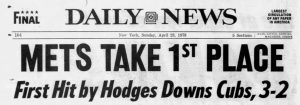
29. 2010
Between April 19 and July 27, I attended fourteen games at Citi Field. The Mets’ record in those contests was 14-0, meaning I was 14-0, easily my most incredible streak of luck in all my years of game-going. The Mets were pretty good at home in that span without me, going 15-12 (versus an abysmal 18-29 road record), but they weren’t utterly incapable of losing like they were when I was around. Somewhere along the way, the Mets’ A/V squad adopted a song called “Uprising” by a band called Muse as their would-be “L.A. Woman” for 2010. If the Mets won at home, the loudspeakers would blare it following a requisite dose of “Takin’ Care of Business”. I heard “Uprising” in regular rotation whether I wanted to or not. Given what it represented, I wanted to hear it in a loop and sort of did. I couldn’t tell you what they played after losses between April 19 and July 27, immune as I was to being there for such unfortunate events. The chorus of “Uprising” ended on a message that spoke to what Muse guaranteed was to come: We will be victorious. Maybe they should have stuck with what had just happened rather than trying to be fortune-tellers; even a fan who was going 14-0 never presumed a win in advance. There was also a line about watching our flag ascend. Alas, no banner other than the star-spangled one rose in Flushing in 2010. Still, when I hear “Uprising” these days, which only happens if I click on the iTunes playlist I complied for myself that season, I’m verifiably unbeatable.
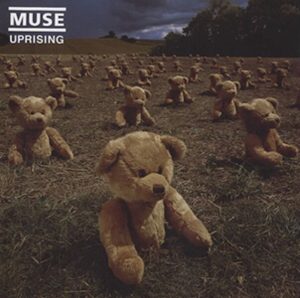
28. 2014
I would hope John Mellencamp doesn’t mind that I’ve retroactively adopted the lyrics from “Cherry Bomb” to describe the year before the Mets won their most recent pennant: “We were young, and we were improving.” I wasn’t really thinking “hey, we are young, and we are improving” as 2014 dragged along, because a) the Mets’ roster included 40-year-old Bobby Abreu and 41-year-old Bartolo Colon, and b) the Mets fell below .500 on May 7, never to rise above it again. We were stuck in a cycle of mediocrity dating back to the opening of Citi Field. Never fewer than 70 wins, never as many as 80 wins. The 2014 Mets topped out at 79. But they also included within their number initially unheralded righty Jacob deGrom (26) earning the Rookie of the Year award; fellow starter Zack Wheeler (24) getting the hang of disposing of innings in a timely manner; revelation reliever Jeurys Familia (24) setting up repurposed closer Jenrry Mejia (24), each of these talented pitchers throwing to an increasingly confident Travis d’Arnaud (25); Juan Lagares (24) presiding over funerals for fly balls in center so consistently that he was awarded a Gold Glove in his first full season on pasture patrol; and less smooth infielder Wilmer Flores (23) brandishing a bat that made a person occasionally stop worrying where the kid from Venezuela’s mitt would fit best. On their better nights, I began to think we had something here. Their better nights leaned to too few and far between, so I didn’t think it that often. Some years it’s hard to see what’s coming together when there’ve been so many years when everything falls apart.
27. 1976
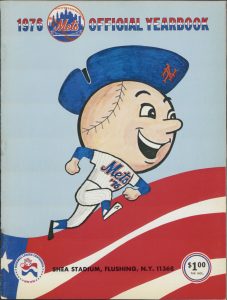 Had I been a less discerning 13-year-old, I’d probably maintain gauzier nostalgia for 1976. A sampler of signifiers pop like the National League centennial patches and special-occasion pillbox hats worn by the Mets that year and only that year. Mike Phillips hit for the cycle. John Milner swatted three grand slams. Bruce Boisclair became Bruce Boisclair. Good ol’ Kooz finally won 20. Dave Kingman was at his Dave Kingmaniest. Brooklyn’s own Lee Mazzilli came up in September and hit a home run that effectively knocked the second-place Pirates from contention. For the very first time in my life, I saw Tom Seaver pitch in person (fittingly enough with no run support in a 1-0 loss). And from 1970 through 1983 inclusive, no Mets team won more games than the ’76 bunch: 86. What’s to be discerning about at that age? Had I been a less discerning 13-year-old, I’d probably maintain gauzier nostalgia for 1976. A sampler of signifiers pop like the National League centennial patches and special-occasion pillbox hats worn by the Mets that year and only that year. Mike Phillips hit for the cycle. John Milner swatted three grand slams. Bruce Boisclair became Bruce Boisclair. Good ol’ Kooz finally won 20. Dave Kingman was at his Dave Kingmaniest. Brooklyn’s own Lee Mazzilli came up in September and hit a home run that effectively knocked the second-place Pirates from contention. For the very first time in my life, I saw Tom Seaver pitch in person (fittingly enough with no run support in a 1-0 loss). And from 1970 through 1983 inclusive, no Mets team won more games than the ’76 bunch: 86. What’s to be discerning about at that age?
Well, there was all that dust the Mets were left in by the Phillies. Pittsburgh wasn’t the only team that couldn’t make a successful run. Our third-place finish by this point was a little too familiar and that 86-victory total, while mathematically more than every Mets club that wasn’t from 1969, was practically as backloaded as Shohei Ohtani’s contract. We were 52-55 on August 2, 34-21 the rest of the way, better than everybody in baseball — 34-16 before an 0-5 sneak preview of 1977 ended the schedule. Even that badge of out-of-it honor was tarnished in May the next year in the wake of the Mets’ godawful start. Speaking for the board of directors, John Payson thought it necessary to visit the clubhouse and read to the players a statement of support for embattled chairman M. Donald Grant (an inversion of Grant telling the players four years earlier that management still believed in them). Within his declaration, Payson reasoned, “Our team played very well after the All-Star game last summer,” plus 1969 and 1973 went so swimmingly. “The Mets have had many early-season slumps and have pulled out of them by playing as a team” was his version of go get ’em. The sparkling conclusion to 1976 had been weaponized in the name of preserving the status of the man who was about to trade Seaver. So thanks for ruining that, too.

26. 1972
In a kinder world, Yogi Berra wouldn’t have been managing, because Gil Hodges would have still been alive, but we got the world we got, and Yogi was now in charge. I knew Jon Matlack and John Milner from veritable cameos the year before; now they were staples of our rotation and lineup, respectively. Rusty Staub? We got Rusty Staub? We did! We got Jim Fregosi? We did. Two distinct All-Star backgrounds, two distinct impacts unfolding. Oh, and Willie Mays. WILLIE MAYS WAS ON THE METS! Meanwhile, five world champions from 1969— Ron Taylor, Al Weis, Donn Clendenon, Art Shamsky and Nolan Ryan — weren’t back from the year before. The 1972 Mets are the first Mets I remember considering materially transformed from the set of Mets who came before them. They still played at Shea, they still featured Seaver, they still finished third and they still limited themselves to 83 wins (albeit in a slightly strike-abridged season), but the times, they were a-changin’. Not necessarily for the worse. Not necessarily for the better. Definitely and necessarily different.
25. 1981
I came roaring into my Age 18 season tacitly determined to be the biggest Mets fan anybody was likely to encounter. I don’t know that there was much competition. Wore my new Starter jacket everywhere, my vintage Mets ski cap when chilly enough. Cut school for the Home Opener (rained out). Withstood a miserable 8-24 beginning to the schedule. Talked myself into endorsing the trade of Jeff Reardon for Ellis Valentine. Lit a candle rather than curse the darkness when the strike wiped out the heart of summer and robbed me of an answer to the trivia question, “What did the Mets do on the day I graduated high school?” (answer: nothing). Rejoiced at the return of baseball, no hard feelings for either side in the labor-management dispute. Had to go to Shea for an intrasquad game open to the public. Had to go to Shea for a tune-up exhibition against the equally woeful Blue Jays. Had to plant myself in front of the TV when the Mets and Cubs commenced the so-called second season on August 10, all also-rans’ April-to-June sins erased, all teams suddenly contenders for a mini-division title and a ticket to the expanded playoffs.
The Mets beat the Cubs in a thrilling Reopening Day extra-inning affair. Natch, I had to keep watching all I could because in two or so weeks, I’d be headed off to the west coast of Florida for college, which would be handy come Spring Training, but wasn’t a particularly Mets-accessible locale otherwise. On the Tuesday afternoon when that series at Wrigley continued, my mother asked me what I was up to. “Gee, I think I’m gonna watch the Mets,” I said with a chuckle. What else would I be doing at this particular moment, especially in 1981? Not only was I running out of Mets time in New York, I hadn’t had any official Mets time for two months. This wasn’t a split season. It was trisected. The “first half” was halted with the Mets 17-34. The “second half” was slathering hope on my wish sandwich — the Mets indeed teased me hard before finishing 24-28. The middle “half,” however, was a big, fat zero-and-zero. No Mets at all. Surely my mother understood that. The strike had been in all the papers.
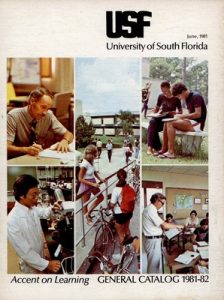
Yet she chose that day in August to project on me her anxieties about how I need to get serious about my studies and what I should really be doing today is bearing down on the course catalog; if I watched baseball instead, I was already showing myself to be on the wrong path for not just college but life. Mind you, I was already enrolled for three of my four first-term classes, but one I’d initially wanted to take wasn’t available when I went through orientation in July, so, yes, there was a piece of unfinished pre-college business hanging in the air. But a) in those pre-computerized days, there was nothing to do about registering until I showed up on campus; and b) I needed to spend three hours and two minutes on this particular day poring over class descriptions? I could have said “three hours” right there, but three hours and two minutes was the length of the Mets’ win over the Cubs on August 11.
I think you know how I spent that Tuesday afternoon…and what path my life was going to take.
24. 1983
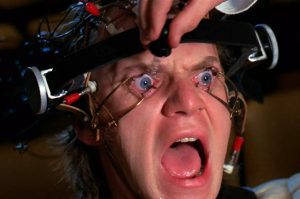 Nobody pried my eyelids open against my will and directed my undivided attention to a screen crammed with disturbing images in the fashion of A Clockwork Orange, but nobody had to. I voluntarily got caught up in a marathon of SNY’s Mets Yearbook series a while back and couldn’t look away, particularly during the deep, deep dive into the second-division epoch that spanned, for me, eighth grade to my junior year of college. Nobody pried my eyelids open against my will and directed my undivided attention to a screen crammed with disturbing images in the fashion of A Clockwork Orange, but nobody had to. I voluntarily got caught up in a marathon of SNY’s Mets Yearbook series a while back and couldn’t look away, particularly during the deep, deep dive into the second-division epoch that spanned, for me, eighth grade to my junior year of college.
The 1977 edition: Someday, according to manager Joe Torre, we’re going to remember the Tom Seaver trade as the Steve Henderson trade.
The 1978 edition: Bob Murphy introduces us to new board chairman Lorinda de Roulet, who promises us everything’s going to be just swell in 1979.
The 1979 edition: Here’s a visit with Ed Kranepool to remind us that he, like the most grizzled viewer, is a survivor of everything this franchise has dished out.
Dollops of whimsy filtered in throughout to leaven the presentation — who doesn’t love utility infielder Bobby Valentine copping to winning Bazooka’s bubble-blowing contest by charming a lady judge? — but an undercurrent of inescapable horror lodged itself within my psyche as I was being reminded of how bad those teams and seasons truly were and how as my adolescence morphed into my early adulthood, I kept requesting, in so many words, more please. It went on like that into the 1980s, particularly 1982, the sixth of these repurposed highlight films from the dark ages, when three separate times narrator Steve LaMar, new and ultimately forgotten radio voice of the New York Mets, flogged the wonders of DiamondVision.
Just when I was about to scream, “I CAN’T TAKE IT ANYMORE!” decades after, in fact, I took it continuously, Mets Yearbook: 1983 airs and hints that this segment of the rewinding of my Met life is about to be over. Darryl Strawberry has arrived. Keith Hernandez has been traded for. Tim McCarver narrates, so even the voicing steps up in class. Seventh time was the charm. We know because of what came directly after 1983 that any propagandistic retelling of this cellar-dwelling year lands in the succeeding century as a hindsight special. Why was this 90+ loss season different from all other 90+ loss seasons? Because it would be followed by a string of 90-win and better seasons. You sensed it at the time even if you couldn’t identify exactly what awaited beyond the orange-and-blue horizon. We had to get out of the sixth place if it was the last thing we ever did. Turned out escaping the basement was next on our agenda.
23. 2008
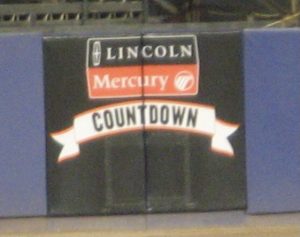 Stupid hypothetical question ideal for sports talk radio at its insipid finest: you can have only one of two — a playoff spot clinched on the last day your team is scheduled to play baseball in the only ballpark you’ve ever known as yours OR a fitting goodbye to that ballpark. The catch is that if you get the postseason berth, the only farewell your team sanctions is the handing out of ticket applications for the new ballpark next door, brought to you by your New York-New Jersey Lincoln-Mercury dealers. Which do you choose? I’ll hang up and listen. Stupid hypothetical question ideal for sports talk radio at its insipid finest: you can have only one of two — a playoff spot clinched on the last day your team is scheduled to play baseball in the only ballpark you’ve ever known as yours OR a fitting goodbye to that ballpark. The catch is that if you get the postseason berth, the only farewell your team sanctions is the handing out of ticket applications for the new ballpark next door, brought to you by your New York-New Jersey Lincoln-Mercury dealers. Which do you choose? I’ll hang up and listen.
You should be able to have both, but that’s not how stupid hypothetical questions work. In reality, more consistent clutch hitting or merely serviceable relief pitching would have earned the 2008 Mets at least a Wild Card slot, perhaps the National League East title, and from there, who knows what festive occasion well into October serves as backdrop for Shea Stadium’s final baseball game? Instead, we sustain our second annual Closing Day punch to the gut to seal shut Shea’s 45th and final season on September 28, getting eliminated from the playoff picture in the process…yet have our broken heart mended as best as possible under dreary circumstances by a postgame parade of Met legends, semi-legends and legends mainly to us whose presence is announced by our beloved Howie Rose.
Jack Fisher and Ron Hunt.
The Glider and The Stork.
Little Al Jackson and Big Dave Kingman.
Buddy and Rusty.
Swannie and Mazz.
Mex and Kid.
Fonzie and Robin.
An array of league champs and world champs.
Already inducted Mets Hall of Famers and surefire Mets Hall of Famers once the Mets remember they have a Hall of Fame.
Wayward favorite sons Darryl Strawberry and Dwight Gooden.
The one and only Willie Mays.
The one and only Mike Piazza.
The one and only Tom Seaver.
They all acknowledge us. We acknowledge all of them. Howie instructs each of them to touch home plate. Each of them touches us in doing so. The Beatles’ “In My Life” is cued up. Tom toes the rubber and sets and fires to Mike in his crouch. It’s a called strike last. The battery of a Met lifetime strolls together toward the 410 sign in center (emblazoned on a temporary panel of an outfield fence already being sold in sections on the memorabilia market, but we’ll overlook that discordant note for the moment). It’s the perfect sendoff on a most imperfect day, the epitome of taking the bitter with the sweet, the sweet finishing percentage points ahead.
I’m sorry, was there a question?
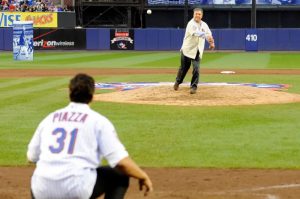
by Greg Prince on 15 January 2024 4:01 pm Welcome to the second installment of MY FAVORITE MET SEASONS, FROM LEAST FAVORITE TO MOST FAVORITE, 1969-PRESENT, a continuation of the project I introduced on my birthday. The ten seasons spotlighted below I liked a little more than the dozen I counted down on December 31, not as much as the thirty-three that are still to have their number called.
As we creep out of the shadow of the “LEAST” end zone (forgive the football terminology), I’m sticking with the notion of saying something nice about seasons that weren’t that nice, though this time around being less purely anecdotal and attempting more to identify how their essence meshed with my experience when they were live. Each of these campaigns had something going for them for at least a little while; a couple even ended with winning records. I didn’t find them close to ideal, but there were threads that stay with me that didn’t strangle my Metsian enthusiasm.
This is a personal appraisal. My ranking of a season as “37th-favorite” is neither right nor wrong. It is mine. Some of these capsules lean to the first-person. Some spout numbers as if I were the offspring of two computers. Both forms of expression indicate how I interpret this ballclub. Were the Mets making me feel good in the year in question? Were the Mets actually good in the year in question? The seasons the Mets strove sincerely for success and succeeded to some degree tend to place higher with me. This group of years falls short on that count, yet for a week or a month, I believed they were getting there. Or maybe they were just giving me something I needed to keep going as a Mets fan.
I was gonna keep going, regardless, but a boost in the right direction is always appreciated.
***43. 2021
Processing the competitive contours of the 2021 season less than three years after the fact, I find it shocking to remember the Mets were a first-place ballclub from early May to early August. I would say they “commanded” the NL East for three “solid” months, but their lead was gelatinous and their command never more than tenuous. I find it better to forget the false summer of divisional dominance along with the frustration that abounded once it dissipated and recall instead the true purpose of our first full season of baseball since COVID entered the atmosphere. Call 2021 a rehab year for us as fans. Learning how to finish out Spring Training again. Learning how to start a season more or less on time again. Seeing and hearing some people in a ballpark again. Becoming one of them once it felt OK. Remembering what you could and couldn’t bring to a game — and that you might as well keep a mask handy. Willing to almost convince ourselves this Met team might stick around until October. Fuming when the standings finally reflected our doubts. Glad to be done with this season, antsy for the next one. Normality crept back into our routines. We regained the hang of what came naturally…including falling out of the race when it turns out the Mets aren’t really very good.
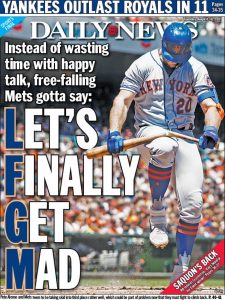
42. 2004
“That uneasy alliance between Bright Young Things and old survivors” was a phrase spoken in a 2003 film that foresaw what was coming at Shea Stadium the very next year. From Fred Wilpon’s nostalgic haze for the Dodgers emerged a parade of veritable codgers: Franco, Leiter, Gl@v!ne…ten dudes in all born the same decade I was, which was several decades before, and nobody was scouting this veteran of the baseball scene. Seven Mets were older than Mike Piazza, history’s greatest-hitting catcher judged to have gotten so up there in years that he was directed to try his mitt at first base. But for a while, the old guys still had it. Crustiness notwithstanding, the 2004 Mets moved to within one game of first place on July 7. The creaky nature of the operation began to show, and there went both contention and Wilpon’s dream of meaningful games in September, a month when the franchise for a third consecutive season went to seed. Yet there was that bright young Jose Reyes, when his hamstrings were loose, preparing to reclaim shortstop from Kaz Matsui (what was up with that?), and there was that bright young David Wright, once he had enough Triple-A under his belt, getting promoted and driving in runs. I leapt from my seat for mind-boggling home runs from Victor Diaz, 22 (his career first), and Todd Zeile, 39 (his career last), eight days apart. I didn’t know where we were going, but I figured we’d get there eventually.
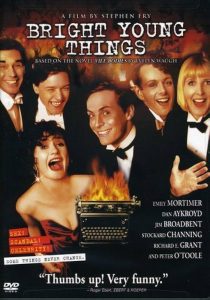
41. 2012
I’m tempted to say we should have called it a season once Johan Santana made our dreams come true by throwing The First No-Hitter in New York Mets History on June 1, but then we would have missed R.A. Dickey’s incomparable journey to Twenty Wins. I’m tempted to say that we shouldn’t have bothered with anybody’s post-Nohan starts except R.A.’s, but then we would have missed the sizzling batch of innings dropped on our plates by prodigy pitcher Matt Harvey. Well, maybe arrange to consume only the most uplifting starts of Santana’s, Dickey’s and Harvey’s — but then how do you enjoy David Wright’s last full-on MVP-caliber campaign, including the night he broke the franchise hit record? Jeremy Hefner started for us that night, so you kind of had to watch everybody. There were many gobs of good to 2012, even the illusion that 2012 was going to be something beyond the ordinary, and not just because of the occasional à la carte splash. We were seven games over on July 7 before finishing fourteen games under at the close of business on October 3. With the second half came a baseball bout of seasonal affected disorder, a.k.a. SAD. Essentially six days of gray skies per week, then there’d be one day the sun would burst through. Somebody would do something exhilarating or downright historic, we’d high-five across our screens, and then we’d be back to moping. Based on the composition of the roster, you could have forecast that’s how it would go. Still, those days that weren’t dreary made you want to believe Met-eorologists aren’t always accurate.
40. 2011
This team had spunk. Lou Grant might not have approved, but he wasn’t our news director. The news for us as 2011 unfolded was the Mets weren’t nearly as bad as they could have or should have been amid the depths of the Bernie Madoff fallout. They weren’t terrific by any means, nor did we expect them to be. They started the season with Brad Emaus at second base. I try to resist picking on individual players as illustrative of how hopeless the overall situation was in a given year, but I repeat: we started the season with Brad Emaus at second base. Because he was a Rule 5 pick plucked from the Blue Jays, we had to keep Emaus on the active roster or risk losing someone who was supposed to be our offseason bargain. Having gotten off to a 5-13 start, which nobody bargained for, maintaining Brad Emaus emerged as less than a priority and he went back to the Toronto organization before April was over. Terry Collins’s first crew, once Eamusless, began to demonstrate bona fide competence, busting past the .500 barrier for a spell and displaying a knack for now and then capturing games that appeared utterly out of reach. Down 7-0 to the Pirates after two-and-a-half on June 2, the Mets won, 9-8. Down 6-1 to the Cardinals — a team rampaging toward a Wild Card that they would exchange for a world championship — after seven on September 22, the Mets won, 8-6. The season was speckled with Mets Classics that never get reaired as such. If SNY did show them again, would you recognize half the players? Loads of Emauses (Emaii?) made their Met entrances and exits in 2011. Blaine Boyer! Taylor Buchholz! Chin-lung Hu, for whom a question mark would serve as effectively as an exclamation point! Willie Harris, who you likely remember far better as a homer-thieving Met villain than any kind of Met helper, played in 126 games, as many as chronically hamstrung batting champ Jose Reyes (Willie drove in the go-ahead runs in that Cardinal comeback). Jason Pridie, who you likely barely remember if at all, played 101 games — one fewer than David Wright did the year The Captain was first compromised by back issues, and 32 more than he himself played total in snippets of six other seasons for six other teams (Jason drove in the winning run in the game that followed the Pirate comeback). Val Pascucci socked 21 home runs at Buffalo, earning himself a September callup after a seven-year absence from the majors (his one Met homer broke up Cole Hamels’s no-hit bid). This team also had Francisco Rodriguez and Carlos Beltran, guys who are receiving Hall of Fame votes more than a dozen years later, but traded them both in July despite having arrived at the fringes of the playoff race with them in tow. The day Beltran was swapped to San Francisco for minor leaguer Zack Wheeler, we were one game behind St. Louis. We understood the business reasons that dictated shying away from going for it. We understood the 50-38 stretch that erased the Emausosity of our start was mostly a spunky mirage. We understood limping to the finish line well out of the money was inevitable. We can be ridiculously understanding that way.
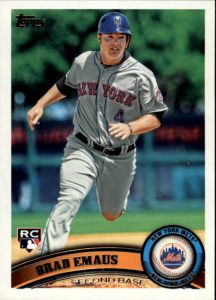
39. 2013
The blob of non-competitive baseball conducted by undistinguished Mets collectives that filled the years between the dismantling of Shea Stadium and Citi Field’s eligibility to host postseason contests does its best to exist as a blur a decade later. One year’s very like another/when your head’s down over the standings, brother. Yet 2013 stands out clear in the mind’s eye if I squint hard enough…and I do like to squint. The 2013 Mets dealt us multiple nadirs early and late, but there was a stint when they rose to the level of their best pitcher, Matt Harvey, and their best player, David Wright, and their ballpark’s signature attraction to date, the All-Star Game (in which the National League started Wright at third and Harvey on the mound). For a month-plus, surrounding the Midsummer Classic’s first trip to Flushing in 49 years, the world resembled the Mets’ oyster. An array of second-line overachievers played with pep and zip and verve and panache, leaving me believing they weren’t necessarily going to lose every night. Everybody from David Aardsma — who usurped Don Aase’s spot atop the alphabetical cataloguing of the all-time roster — to Eric Young, Jr. — who swiped a stolen bases crown after coming over from Colorado — kicked in a little something. You couldn’t spell Mentos without Mets, and this was our freshmaker period. So what if it lasted not much longer than a mint in your mouth? The 22-14 spurt didn’t erase the dreadful 24-39 stumble out of the gate, and it didn’t prevent a 28-35 fizzle to the finish line, but somewhere in there was a real team to get real excited about.
38. 2018
Thirty days hath September/April, June and…oh, those months of magical, tragical thinking. Going chronologically and allowing ourselves some leeway for a season that started on March 29, we were treated to the best Mets team ever for the first nine, ten, eleven, twelve, thirteen and fourteen games of 2018, accomplishing unheard of Met records like 11-1 and 12-2. The blistering pace couldn’t last, but the Mets were still in first when April ended. Shockingly, they weren’t in last when June was over, though not for lack of trying. The same team that ripped off a record-setting start plummeted from one game above .500 on May 30 to sixteen below exactly one month later. The 5-22 nosedive told us everything we needed to know about who the 2018 Mets were…until September, when an 18-10 end run had us reconsidering. ”Well, if we could just subtract June…” Calculating wins and losses could be a confounding exercise that year. I know for certain I saw Jacob deGrom pitch to a 1.70 ERA across thirty starts, and it was stupendous, yet I also know I saw Jacob deGrom collect 10 Ws against 9 Ls, and that was stupefying.
37. 1996
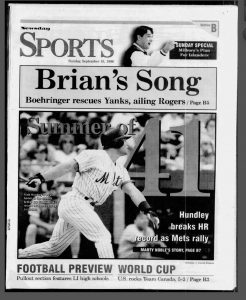 I felt something for this team amid the dregs of September that had been missing from the vast expanse of dismay that turned April through August into such a drag. A whiff of a hint of a clue that better days were ahead for this 91-loss jugger-NOT? Not exactly. The numerical pursuits of Todd Hundley (41 homers) and Lance Johnson (227 hits) certainly kept me leaning forward, but it was also what was going on across town. The Yankees were nearing their first divisional title in fifteen years and taking too much of New York with them. Subconsciously or otherwise, I dug into my historical position. I shall not be moved. I climbed aboard a similar municipal bandwagon in the mirror image year of ’69, embraced the Metropolitan ethos I encountered as a lad, and never thought to exit. In ’96, trends were whooshing in the other direction. I lived through that sort of reverse commute in the late ’70s, right around the same moment Time columnist Joel Stein was experiencing his baseball awakening as a kid in Jersey. Reggie. Billy. George. Toxic tea for those so inclined. In 2000, when the Subway Series loomed and the Yankee express had been running nonstop for five seasons, Stein explained the roots of his pinstriped allegiance: “My father, who grew up in the Bronx, took me to Yankees games. He is one of those tough Yankees fans who liked the Yankees aspirationally, because many lived the glamorous, drunken, bar-fighting, womanizing lives he wanted to lead, and then did after he got divorced.” Stein concluded that despite the Met motif better reflecting his own self-effacing tendencies, “I can’t get myself to switch allegiances…simply because the Yankees win.” Ya wanna be that way, fine — there’s a team for that. We knew that’s how their bandwagon rolled in 1996, even in the moments before it all became certifiably dynastic and intolerable. My sensibilities were offended that the Yankees of Joe Torre and Don Zimmer and Darryl Strawberry and David Cone (with Dwight Gooden having socked away a no-hitter) were getting points for being something akin to lovable underdogs. They’re not lovable. They’re never underdogs. Do your winning, but do it like the pricks you are. Hands off our brand equity. “Fuck you, I’m a Mets fan” was my attitude that September when “all of New York” was alleged to be excited about the Yankees. It carried me through October and toward those better days, too. I felt something for this team amid the dregs of September that had been missing from the vast expanse of dismay that turned April through August into such a drag. A whiff of a hint of a clue that better days were ahead for this 91-loss jugger-NOT? Not exactly. The numerical pursuits of Todd Hundley (41 homers) and Lance Johnson (227 hits) certainly kept me leaning forward, but it was also what was going on across town. The Yankees were nearing their first divisional title in fifteen years and taking too much of New York with them. Subconsciously or otherwise, I dug into my historical position. I shall not be moved. I climbed aboard a similar municipal bandwagon in the mirror image year of ’69, embraced the Metropolitan ethos I encountered as a lad, and never thought to exit. In ’96, trends were whooshing in the other direction. I lived through that sort of reverse commute in the late ’70s, right around the same moment Time columnist Joel Stein was experiencing his baseball awakening as a kid in Jersey. Reggie. Billy. George. Toxic tea for those so inclined. In 2000, when the Subway Series loomed and the Yankee express had been running nonstop for five seasons, Stein explained the roots of his pinstriped allegiance: “My father, who grew up in the Bronx, took me to Yankees games. He is one of those tough Yankees fans who liked the Yankees aspirationally, because many lived the glamorous, drunken, bar-fighting, womanizing lives he wanted to lead, and then did after he got divorced.” Stein concluded that despite the Met motif better reflecting his own self-effacing tendencies, “I can’t get myself to switch allegiances…simply because the Yankees win.” Ya wanna be that way, fine — there’s a team for that. We knew that’s how their bandwagon rolled in 1996, even in the moments before it all became certifiably dynastic and intolerable. My sensibilities were offended that the Yankees of Joe Torre and Don Zimmer and Darryl Strawberry and David Cone (with Dwight Gooden having socked away a no-hitter) were getting points for being something akin to lovable underdogs. They’re not lovable. They’re never underdogs. Do your winning, but do it like the pricks you are. Hands off our brand equity. “Fuck you, I’m a Mets fan” was my attitude that September when “all of New York” was alleged to be excited about the Yankees. It carried me through October and toward those better days, too.
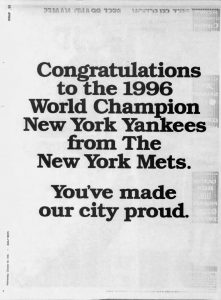
36. 1991
It’s July 13. The Mets win seven in a row right before the All-Star break and three directly after it, stomping on the Expos, the Phillies and the Padres in succession. We’re two-and-half out. Great, we’re making our move. It’s July 21. An up-and-down homestand ends with Doc Gooden beating the Dodgers by doubling a run home off Bobby Ojeda in the third and striking out Darryl Strawberry to end the fifth; serves them right for not being Mets anymore. We’re four out. Still plenty close, here we come. It’s August 8. After a messy trip out west, we take two out of three from the Pirates, the team we’re chasing, Gooden and Viola making the Bucs walk the plank on consecutive nights. We’re five-and-a-half out. Not ideal, but there are still two months to go and we’re gathering momentum. Three times my confidence has crested in the 1991 Mets. Thrice I have been convinced that my flawed team is ultimately capable of contention, meaning an eighth consecutive year of, at the very least, making a push in September is at hand. They lose 34 of their final 54 and no longer resemble the team I lived and died with from 1984 forward. They die on me in 1991. Rest in peace, Met era like no other.
35. 1989
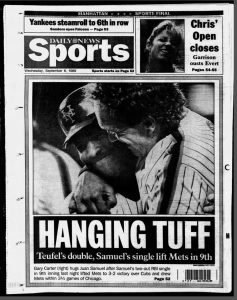 New Kids on the Block had a bunch of hits. One of them inspired the headline that graced the back page of the Daily News late that summer: HANGING TUFF. It wasn’t to describe the exploits of a lynch mob, but to assess how on September 5 the Mets, led by their veteran pinch-hitter, pulled out a walkoff win versus the Cubs at Shea, moving them to within 3½ games of first-place Chicago with 25 to play. With the score tied at two, Tim “Tuff” Teufel batted for starter Sid Fernandez with one out and doubled. Lou Thornton ran for him and moved up to third on Gregg Jefferies’s fly ball. Juan Samuel singled him in. After a torrent of tumult, turmoil and turbulence that transformed a flattering profile of the Mets as “the IBM of baseball” in Manhattan Inc. magazine into the prototype of a Freezing Cold Take and cast the season’s advertising slogan of “Excellence. Again and Again.” as the height of hubris, Amazin’ vibes reigned anew. The Mets had pissed away every chance to step up in the division, yet they were still standing, too good and too feisty to go quietly. Two weeks later, they were barely hanging on. A mini-scandal erupted with the revelation that their reaction to a 1-0 loss in Montreal was to file into the TV lounge off the visiting clubhouse and get engrossed in a football game —making “more noise than we make when we score a run,” per one “disgusted veteran” — just like any group of sports-minded guys on a Sunday afternoon. In their subsequent series at Wrigley, they brought more media grief upon themselves when Darryl Strawberry and Kevin McReynolds vacated the bench in the ninth inning of an apparently hopeless 10-3 game, perhaps to get an early start on changing into street clothes, maybe to check in on the Broncos-Bills tilt happening that Monday night. Except the Mets rallied at the ballpark where no lead is safe. Straw had to be summoned from the clubhouse to bat with two men out and three men on and the Mets suddenly trailing by four. Darryl struck out to end the game, with K-Mac grudgingly on deck. Davey Johnson fined the heart of his order. Elimination was inevitable. Teufel, the last hero of 1989, reflected as Met opportunity diminished, “No one should be surprised where we are. We’ve proven we’re a little better than a .500 club, and we’ve never done anything to become a .600 club.” Turned out they weren’t too good to go quietly. The club finished second, winning 87 times, but this edition never truly had the right stuff. New Kids on the Block had a bunch of hits. One of them inspired the headline that graced the back page of the Daily News late that summer: HANGING TUFF. It wasn’t to describe the exploits of a lynch mob, but to assess how on September 5 the Mets, led by their veteran pinch-hitter, pulled out a walkoff win versus the Cubs at Shea, moving them to within 3½ games of first-place Chicago with 25 to play. With the score tied at two, Tim “Tuff” Teufel batted for starter Sid Fernandez with one out and doubled. Lou Thornton ran for him and moved up to third on Gregg Jefferies’s fly ball. Juan Samuel singled him in. After a torrent of tumult, turmoil and turbulence that transformed a flattering profile of the Mets as “the IBM of baseball” in Manhattan Inc. magazine into the prototype of a Freezing Cold Take and cast the season’s advertising slogan of “Excellence. Again and Again.” as the height of hubris, Amazin’ vibes reigned anew. The Mets had pissed away every chance to step up in the division, yet they were still standing, too good and too feisty to go quietly. Two weeks later, they were barely hanging on. A mini-scandal erupted with the revelation that their reaction to a 1-0 loss in Montreal was to file into the TV lounge off the visiting clubhouse and get engrossed in a football game —making “more noise than we make when we score a run,” per one “disgusted veteran” — just like any group of sports-minded guys on a Sunday afternoon. In their subsequent series at Wrigley, they brought more media grief upon themselves when Darryl Strawberry and Kevin McReynolds vacated the bench in the ninth inning of an apparently hopeless 10-3 game, perhaps to get an early start on changing into street clothes, maybe to check in on the Broncos-Bills tilt happening that Monday night. Except the Mets rallied at the ballpark where no lead is safe. Straw had to be summoned from the clubhouse to bat with two men out and three men on and the Mets suddenly trailing by four. Darryl struck out to end the game, with K-Mac grudgingly on deck. Davey Johnson fined the heart of his order. Elimination was inevitable. Teufel, the last hero of 1989, reflected as Met opportunity diminished, “No one should be surprised where we are. We’ve proven we’re a little better than a .500 club, and we’ve never done anything to become a .600 club.” Turned out they weren’t too good to go quietly. The club finished second, winning 87 times, but this edition never truly had the right stuff.

34. 1971
When Rosalynn Carter died in 2023, it was noted that she and Jimmy lived in the same “modest” house they moved into in 1961. Of course there were extended stretches when they bedded elsewhere, like when Jimmy was governor and president, yet they always returned to Plains, Ga. The 1971 season may be my version of their humble abode at 209 Woodland Drive. Homey. Comfortable. Sufficient as long as we had our trophy from 1969 sitting over the fireplace to remind us we’d been somewhere. It was a New York Met state of mind I got used to. Tom Seaver was magnificent. Everybody else was more or less OK. The team was good enough to not be bad, lacking too much to be great. It wasn’t a whole lot different from 1970, except Pittsburgh put more space between themselves and the rest of the East, so no pennant race transpired, at least not one involving us. There was a little more Ken Singleton, who the announcers seemed excited about, and they loved to tell us Danny Frisella threw a forkball. Don Hahn was here instead of Ron Swoboda. Mostly the same agreeable roster. Exactly the same respectable record of 83-79. I was eight and semi-content to tie for third if this was how it was gonna work every year…though even homebody Jimmy Carter aspired to hold office in Atlanta and Washington, and then traveled the world ambitious to make a difference for as long as his health would allow him. So, yeah, you need to have goals. And, no, you can’t live in 1971 forever.
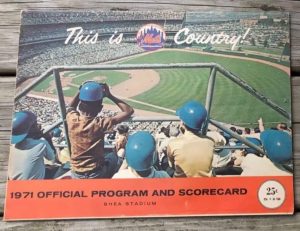
by Greg Prince on 11 January 2024 1:17 pm During his entire active tenure as a New York Met between 1965 and 1977, Buddy Harrelson never played a position besides shortstop, yet I find myself today thinking of his versatility. He could be described as the heart of the Mets, the soul of the Mets, the spirit of the Mets. I think I’ll go with spirit. The Mets as a whole at their best when Harrelson was in his heyday played like nine Buddy Harrelsons. A more spirited team you would not find, though they weren’t exactly short on heart and soul.
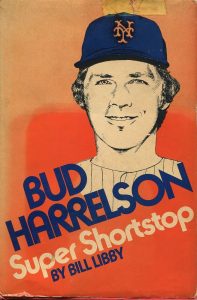
It’s fitting that any of those would work, in that Harrelson would answer to his given name of Derrel (though only Ed Kranepool called him that), Bud (the nickname his family pinned on him when his brother couldn’t quite say “brother,” and it came out “bubba,” which, as nicknames will, morphed into something else) or Buddy, as if “Bud” was too formal. I can’t track down the quote, but I clearly remember reading a passage in the past fifteen or so years in which Harrelson said he liked “Buddy” best because it was friendly. So was he.
Heart, soul, spirit, shortstop, speedster, scrapper, star, champion, coach, manager, scout, broadcaster and, out in Central Islip, owner and ambassador. Versatile Buddy Harrelson did it all in these parts. A mainstay on our baseball scene for most of the years the Mets have existed. One way or another, you knew he was around. That’s how a spirit operates.
Buddy has died at 79, about six years since he went public with his diagnosis of Alzheimer’s Disease. Once in a while, we’d hear about his condition. It was never one that had any hope of improving, but he hung in as long as he could, and goodness knows his family played to the last out. This is one of those passings you were conscious was coming. Nevertheless, his presence to Mets fans won’t be going anywhere soon.
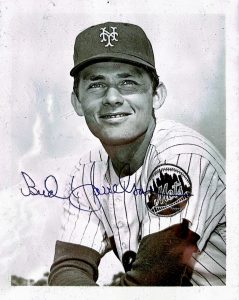
You can still see him, right?
He’s leaping in that montage on Channel 9 while “Meet the Mets” plays and participating sponsors are recited.
He’s dashing out into shallow left to pull in a popup other shortstops might not get to.
He’s turning another year older on D-Day.
He’s sliding into third with another triple.
He’s safe at home, no matter what Augie Donatelli thinks.
He’s absorbing whatever Pete Rose dares to dish out.
He’s “roomie” in whichever anecdote Tom Seaver is sharing.
He’s yukking it up with Ralph on Kiner’s Korner.
He’s attracting more popular votes than Don Kessinger.
He’s accepting a Gold Glove.
He’s coming off the disabled list and making all the difference defensively.
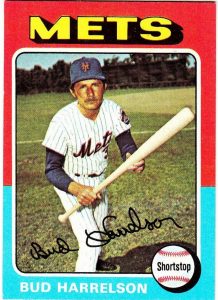 He’s so smooth on the double play. He’s so smooth on the double play.
He’s advising Kevin Mitchell to look alive, Bob Stanley might throw one in the dirt.
He’s teaching the pitchers to bunt.
He’s switch-hitting at Casey Stengel’s behest.
He’s refining his fielding under the tutelage of Roy McMillan.
He’s trying to get comfortable on SportsChannel.
He’s fulfilling his contractual obligations on WFAN.
He’s mentoring Kevin Elster at Little Falls.
He’s giving signals in the “Let’s Go Mets” video.
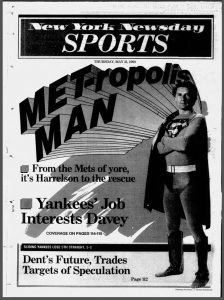 He’s striving to live up to the example of Gil Hodges set for him once he’s asked to succeed Davey Johnson, though he was perfectly content serving under a skipper rather than suddenly being one. He’s striving to live up to the example of Gil Hodges set for him once he’s asked to succeed Davey Johnson, though he was perfectly content serving under a skipper rather than suddenly being one.
He’s back at Shea, a place he should have never been asked to leave.
He’s back at Citi, no matter how difficult being there for the last time was going to be.
He’s going into the club’s Hall of Fame alongside Rusty Staub in the first class of players.
He’s signing enough autographs to paper over Nassau and Suffolk counties.
He’s letting you try on one of his World Series rings if you like — he earned two as a Met, one more than any person ever earned while in uniform.
Bud Harrelson played two seasons for the Philadelphia Phillies and one for the Texas Rangers and put the Long Island Ducks on the map. We had Buddy first and most. Forever our shortstop. Always our Buddy.
by Greg Prince on 10 January 2024 2:50 pm I don’t know how much I will miss Luis Guillorme in practice. His production declined precipitously last season and his defense wasn’t the revelation it once was. Yet Luis’s definitive departure from the only team we have ever known him as a part of — the former Met has signed with the Braves, making him, in my pal Joe’s parlance, a “dirty traitor” — has awakened a wistfulness inside me that has laid dormant throughout this offseason.
I’m not happy to know a Met I cheered for has a joined a team I root against. Still, I’m happy to discover I still care enough to experience any emotion about any Met coming or going. Players have come since the close of 2023, none of whom I am excited to step right up and greet, let alone meet, as Mets. Perhaps it’s because they all seem to have been selected in the middle and latter rounds of a low-rent fantasy draft. Not much hype to believe, regardless of how many dancers are cast within the Queens Crew. Players have gone in the same period, and I’ve held my tongue issuing warnings about what the door might do to do their posterior on their way out. Bidding adieu to bit contributors to an 87-loss team tends to keep eyes from turning dewy. Nothing personal against any of those who newly fit the descriptions of Impending Met or Former Met. Nothing personal at all. This person has felt next to nothing for this team’s transactions in whatever direction they’ve headed.
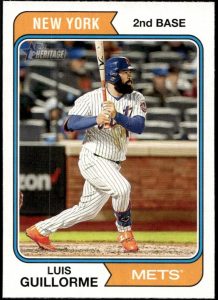 That beard! Then Luis Guillorme goes and spoils it all by saying something stupid like, “I want to be an Atlanta Brave.” You take a lifetime Met, which being around since 2018 will qualify a person as in 2024, and you place him in any other uniform, it will tug at your Metstrings a little. He opts for the uniform with the tomahawk on the chest, and for the park with the chop in the stands, and for the team that’s finished ahead of ours every year since Luis Guillorme has been a major leaguer, it will burn. But stepping back and considering his Mets tenure pre-filthy treachery will also spark your hot stove sentimental pilot light.
The Mets can replace Luis Guillorme’s function. They already have with several versions of Luis Guillorme. Joey Wendle seems to be a Luis Guillorme type. Zack Short seems to be a Luis Guillorme type. Maybe Jose Iglesias. How about Diego Castillo? It’s not as if utility infielders don’t roam the earth brandishing versatile gloves on one hand and invitations to camp in the other.
But if Luis Guillorme was that easy to replace as a presence, why didn’t Danny Mendick stick on the bench or in our hearts? How is that Jonathan Araúz has joined Shohei Ohtani, Yoshibu Yamamoto and who knows how many other international superstars on the Dodgers? Why didn’t New York love Bill Pecota? There are fringe players and then there are players who weave themselves into the fabric of our franchise for a spell despite playing maybe three innings maybe three times a week if nobody else is injured. It’s the difference between swooning over characters we call Hot Rod or Super Joe and being oblivious to the unconditional release of Deven Marrero or Yolmer Sanchez.
Luis Guillorme calmly caught a flying bat of the wooden variety in the dugout in Spring Training a year prior to his official debut, making him a meme before he’d ever played as a Met.
Luis Guillorme worked a 22-pitch walk in another Spring Training. It didn’t count unless you saw it. And then you counted to 22.
Luis Guillorme sported a beard that was so fulsome that it shamed James Harden into demanding a trade out of Brooklyn, knowing these five boroughs were only big enough for one of their hirsute visages.
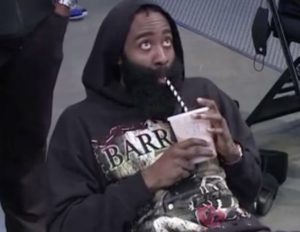 Luis Guillorme sported a visage James Harden could only look up to. Luis Guillorme was accompanied to the plate at Citi Field by the strains of Stories’ 1973 hit “Brother Louie,” which was both somewhat on the nose and practically perfect. Nothing bad, it was good.
Luis Guillorme pitched three times total, more than any Met position player ever and as much if not more than quite a few 2023 Met pitchers.
Luis Guillorme responded to Buck Showalter’s inquiry regarding whether he wore a cup by holding up his hands and declaring, “This is my cup.”
Luis Guillorme carried the nickname “Los Manos” in honor of those skilled hands.
Luis Guillorme was, when the Mets were at their best during his tenure, the archetype of what his manager believed merited a larger and warmer spotlight. “There should be a category in the All-Star Game, for lack of a better expression, for a utility player,” Buck Showalter said during the first half of 2022. “You can’t win without one. There should be a column for those guys. They should get recognized. Kind of like Guillorme. They’re very valuable.”
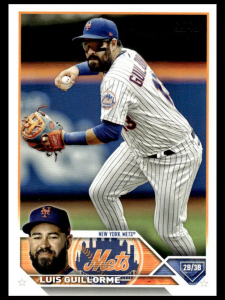 Those hands! Luis Guillorme was indeed very valuable for the 2022 Mets when they were flying their highest, filling in a whole bunch at second and third and never making Buck regret the choice defensively or beat himself up over it offensively.
Those hands could grab anything and get rid of it ASAP. That bat had its moments. The steadiness was reassuring. The mien was captivating. Luis may have peaked as a Met in 2022, which is bad news once the calendar flips to other years, but one of the benefits of long-term fandom is affinity for guys who stick around. For six seasons, options to Triple-A notwithstanding, Guillorme was a Met a Mets fan got used to and occasionally rewarded by. You let those guys go and sometimes it ends up not mattering. Sometimes they become Justin Turner. That probably won’t happen with Luis Guillorme, but who saw it coming with Justin Turner?
At least Justin Turner didn’t go to the Braves.
I had a blast talking writing, music and lots of Mets with Ed Rising on Ed’s Pop-O-matic Podcast. You can check out the show here.
by Jason Fry on 7 January 2024 11:27 am Horrible weather, horrible offseason, horrible everything. You know what might put some pep in our collective step? Looking back at guys who made their Mets debuts during the horrible 2023 season! Some of these guys have already vanished from memory; others we merely wish we could unremember. Like I said, horrible. But they matriculated in 2023 and so are now proud members of The Holy Books! Or at least guys we’ll grudgingly admit must be counted as such.
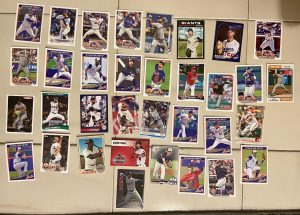 Here they are in all their dubious glory. (Background: I have three binders, long ago dubbed The Holy Books by Greg, that contain a baseball card for every Met on the all-time roster. They’re in order of arrival in a big-league game: Tom Seaver is Class of ’67, Mike Piazza is Class of ’98, Noah Syndergaard is Class of ’15, etc. There are extra pages for the rosters of the two World Series winners, the managers, ghosts, and one for the 1961 Expansion Draft. That page begins with Hobie Landrith and ends with the infamous Lee Walls, the only THB resident who neither played for the Mets, managed the Mets, nor got stuck with the dubious status of Met ghost.)
(If a player gets a Topps card as a Met, I use it unless it’s a truly horrible — Topps was here a decade before there were Mets, so they get to be the card of record. No Mets card by Topps? Then I look for a minor-league card, a non-Topps Mets card, a Topps non-Mets card, or anything else. That means I spend the season scrutinizing new card sets in hopes of finding a) better cards of established Mets; b) cards to stockpile for prospects who might make the Show; and most importantly c) a card for each new big-league Met. Eventually that yields this column, previous versions of which can be found here, here, here, here, here, here, here, here, here, here, here, here, here, here, here, here, here and here.)
For what’s already about the third time, it was a horrible season so let’s get this over with:
Omar Narvaez: A recent and not particularly welcome theme in MetsLand has been the futile quest to find catchers who avoid fates more typically associated with Spinal Tap drummers. Narvaez, once upon a time an All-Star and regarded as a reliable if not scintillating sort, was brought in to keep the seat warm for Francisco Alvarez, or give him more time in the minors, or something along those lines — honestly it wasn’t all that clear, particularly when the Mets also renewed associations with Tomas Nido. It wound up not particularly mattering: Narvaez got hurt, Alvarez took the job, Nido was terrible, and when Narvaez returned he was mostly terrible too. So it went in 2023. 2023 Topps Update card.
Tommy Pham: Pham arrived with a reputation for being intense bordering on dangerously hot-headed and departed having shown us he was the kind of intense the 2023 Mets needed more of. Pham got off to a slow start but even a casual fan could see he was remarkably unlucky, scorching ball after ball right at guys; when his luck finally turned he was a monster, putting up prodigious numbers in June before cooling off and getting flipped to the Diamondbacks, after which we got to watch him on October TV in another uniform. Post-departure he became a go-to quote for the cottage industry of 2023 Mets finger-pointing, calling his former teammates “the least-hardest working group of position players I’ve ever played with.” Before 2023 you probably would have called that “Tommy Pham being Tommy Pham,” now you still might say that, but it would mean something very different. 2023 Topps Update card.
Brooks Raley: A reliever who reinvented himself in Korea before excelling with the Rays, Raley came over to shore up the Mets bullpen and did his job on the field (not an easy task) while also not supplying any chum for a feeding frenzy about players’ personal politics and how those beliefs might or might not be an ideal fit for New York (ditto). If you don’t know what I’m talking about, that’s proof that things went well. Raley will be back next year and it’s actually a relief (ahem) to think about that. 2023 Topps Update card.
David Robertson: A solid veteran brought in as the primary setup guy, Robertson was thrust into the closer job after Edwin Diaz’s knee exploded and he filled in quite ably, though he was unable to prevent the ripple effect of Diaz’s absence impacting those down the depth chart from him. This is one of the important baseball lessons I learned in 2023: On their own, a closer’s numbers can look a lot smaller in value and so easier to replace than, say, a frontline starter’s, but you have to see a closer as the Jenga piece he is and think about the whole of which he’s the critical part. As with many things about the 2023 Mets, it’s a lesson I would have been happier not learning. Anyway, Robertson got shipped off to Miami, signaling the 2023 teardown had begun, and was weirdly ineffective with his new club, which ought to have made me feel better but didn’t. A 2020 Topps card as a Phillie — given his relative importance to his recent clubs, I can only conclude Robertson has offended someone at Topps.
Tim Locastro: Backing up center field is another roster spot that’s lent itself to tragicomic Spinal Tap drummer stuff of late. Locastro looked as fast as promised, got hit by pitches as promised, and got hurt (back spasms, torn UCL in thumb), which was also as promised once you realized he was the new Travis Jankowski who was the new Kevin Pillar who was the new Keon Broxton and so on and so on. (Welcome to Queens, Harrison Bader! I’m sure things will go great!) Locastro’s first hit as a Met was a home run; unfortunately it came in August. 2023 Syracuse Mets card.
John Curtiss: The Mets signed Curtiss in early 2022 knowing he’d be unavailable all year after Tommy John surgery, which was billed as the kind of savvy investment in the future that clubs with money make. And hey, that still may be true! What’s also true is Curtiss was unmemorable as a Met before he was hurt, and is now a free agent. Oh well. Some minor-league card that’s also a horizontal. I don’t have the energy to get angry about these things anymore.
Dennis Santana: No, not Johan, and no, not Cook. A March waiver claim, he spent the year on the Syracuse shuttle, returning and making you say “Oh yeah that guy” before departing once again. Became a free agent in August and will go to spring training as a Yankee. 2019 Topps card as a Dodger.
Kodai Senga: It wasn’t his fault! Pitched well enough to be intriguing at the beginning of the season and got better and better, baffling hitters with his ghost fork and proving a delight to watch. You could see Senga gain confidence as the year rolled along, and his final start was a gem against the Marlins that put him north of 200 strikeouts for the season, making him only the second Mets rookie to do that. Sure, “rookie” gets an asterisk here, but did you watch games in 2023? We’ll take all the highlights we can get, asterisks be damned. 2023 card from the Mets factory team set.
Denyi Reyes: A hulking reliever, he looked effective in April, got torched by the Braves to begin May and wasn’t seen again until August, returning against the Braves and getting torched again in a game the Mets lost by 18. That seems cruel. There’s always a guy (or two) who departs in the spring and returns when there’s a hint of fall in the air, making you say, “Wait a minute, I thought he was [released/retired/missing/in the witness protection program/dead].” 2023 Syracuse Mets card.
Jimmy Yacabonis: I remember him looking determined on the mound while bad things happened around him. Another one of those “gone in May, back in August” guys, his year was a blur of injuries, demotions, going on and coming off waivers and assorted other Quad-A human-resources hijinks. He’s now a Long Island Duck, which players like to see as the start of something new but is more often the end of something old. At least his name was fun to say — between him and Zach Muckenhirn and Jonathan Arauz the Mets excelled in this underappreciated category. 2019 Topps card from better days as an Oriole.
Jeff Brigham: Gets free ice cream at New England’s JV version of Friendly’s! That’s a nice perk! I made that up; Brigham appeared in 37 games and I basically don’t remember him at all, which might say something about him or about me or about both. Anyway, some old Topps Total card as a Marlin.
Edwin Uceta: At least there’s a reason I don’t remember Edwin Uceta — he pitched three innings in a lone April game in San Francisco, busted his ankle and was never heard from again. Some horrid old Bowman card as a Dodger that should be introduced in graphic design classes as an example of what not to do.
Zach Muckenhirn: I always feel for guys with names that make you realize they get at least one item of mail with a misspelling every goddamn day — the “h” in “Zach” is the tricky part here. Anyway, Muckenhirn didn’t make much of an impression with the Mets before being shipped off to the Mariners in return for Trevor Gott and the mummified corpse of Chris Flexen. 2023 Syracuse Mets card.
Justin Verlander: Hey, it seemed like a good idea. Verlander was old but seemed like he had an intact arm and all the other qualities that had made him a lead-pipe-cinch Hall of Famer, so why not shell out north of $120 million to make him the replacement for Jacob deGrom? But then Verlander got hurt and when he wasn’t hurt he too often looked like a $43 million No. 4 starter. The Mets sent him back to the Astros for a pair of top-flight prospects as part of an intriguing teardown that essentially saw them trade for draft picks; in a sublime bit of baseball irony, he wound up opposing recent teammate Max Scherzer in a key Astros-Rangers showdown during the AL West playoff drive. (I remember the matchup but not how it turned out, because honestly who cares.) Verlander’s NEW YORK (N.L.) lacuna in his HOUSTON (A.L.) service time will baffle future visitors to both Baseball Reference and Cooperstown; we’ll be able to grumblingly assure them that it really happened. 2023 Topps card in a Photoshopped Mets uni, which is perfect.
Dominic Leone: When you travel north along the state road to our summer house in Maine you encounter a wooden sign marking a hard-to-see driveway: THE LEONES. It’s basically unobjectionable but a little too big for its surroundings and always reminds me that I’m not as close to home as I thought I was. 2023 Topps card as a Giant, wearing their fog-shrouded alts.
Josh Walker: Generic-looking guy with generic name apparently pitched for the 2023 Mets. The numbers show he was terrible and then got hurt, so I’m glad I don’t remember more than I do. 2023 Syracuse card.
Gary Sanchez: Defensively-challenged former Yankees catcher arrived in May to further complicate the Mets’ catching situation; the team watched him take six ABs and concluded he wasn’t the answer. Sanchez then became a Padre and hit 19 dingers, because of course he did. 2023 Topps card as a Twin.
Grant Hartwig: Hard-throwing righty reliever looked impressive at first, then a lot less so. He’s a rookie, so cut him some slack. He’s also one of many young Mets pitchers you can argue has been taught to pitch against his own best recipe for success, so don’t be surprised if we cut him loose in 2025 and he’s somebody’s closer a year later. Being a Mets fan is fun! 2023 Syracuse Mets card.
Vinny Nittoli: One of those guys who’s been everywhere (man), Nittoli starts 2024 getting paid by the Oakland A’s, his 10th organization. One of a startling number of Mets who’ve logged recent time with the Tacoma Rainers, whose card he gets in THB. I remember nothing else about him, sorry.
Danny Mendick: A former White Sox utility guy whose career was derailed by a knee injury, Mendick didn’t make the Mets out of spring training and his most notable contribution was getting bombed by the Braves when pressed into service on the mound. Somehow got a 2023 Topps Update card as a Met, which is success of a sort.
T.J. McFarland: Was brought into a game at Citi Field in June with the little ribbon scoreboard identifying him as a righty (no) and billing him as LASTNAME (arguably not incorrect but let’s also go with no). At least they got his number (44) right. 2023 Syracuse Mets.
DJ Stewart: One of the few bright spots on the roster as the season crumbled, Stewart showed some pop and looked a lot better than billed playing right field, which isn’t to say it wasn’t an adventure out there. Took the role of “portly lovable slugger” away from Daniel Vogelbach after Vogelbach stopped being lovable. I will now be a scold and remind you that this augurs exactly zero about Stewart’s future prospects. 2023 Syracuse Mets card; I imagine he’ll at least get one flagship Topps card out of this whole adventure.
Trevor Gott: The Mets acquired Gott from Seattle along with recidivist Met Chris Flexen, whom they made clear from the beginning they had no intention of actually doing anything with beyond paying him to not be a big-league ballplayer. That made Flexen the more useful addition, as Gott was numblingly and reliably horrible to the point that I would make the Edvard Munch face when spotting him in the bullpen and pray that an earthquake, a meteor impact or some other act of actual Gott would keep him from making me even angrier about the fact that we share a planet. He’s now an Oakland Athletic and they can fucking have his Jonah ass. Topps Total card as a Giant.
Jose Quintana: An important part of the rotation assembled for 2023, Quintana needed bone-graft surgery to repair a rib fracture and didn’t report for duty until late July, when the season was lost. He pitched well but got basically zero run support, no surprise as the Mets had become a ragamuffin collection of misfit toys. He’s now our No. 2 starter, which wasn’t exactly the plan. 2024 Topps Heritage card.
Reed Garrett: There are 1,458 innings in a baseball season, it winds up taking a lot of dudes to fill them, and a lot of those dudes are interchangeable right-handed relievers. Anyway, some Norfolk Tides card.
Rafael Ortega: Ortega provided another valuable baseball lesson amid the wreckage of the season, playing a capable center field and showing both speed and a little pop, which gave the Mets a bit of up-tempo when everything was down notes. That was a welcome antidote to the disdain with which I’d greeted his arrival — we should never forget that even the last guy on a late-August big-league roster is a world-class athlete who’s done something extraordinary by coming so far. (Stops, sings “Kumbaya.”) Still, it’s also not wrong to say that if Rafael Ortega is a regular in your starting lineup during the pennant drive you’re almost certainly not a part of said pennant drive. 2020 Topps Card as a Cub.
Jonathan Arauz: He had All-Star hair and was at least useful as a Met third baseman, which was a mercy by the time he showed up. Plus Howie Rose had fun saying his name: air-a-OOOOOOZE. Still, he hit .136. Arauz is only 25, so I wouldn’t write him off quite yet, though if he does something of note it’ll be as a Dodger, and they don’t exactly need help. 2023 Syracuse Mets card.
Phil Bickford: A glum-looking middle reliever, Bickford arrived from the Dodgers in return for cash at the end of July and was OK down the stretch. I struggled to remember even that much. Old Bowman card on which he’s … let’s see … a Brewer?
Abraham Almonte: If you say so. Long-ago Topps Heritage card as a proto-Guardian.
Tyson Miller: The only thing I remember about him is he arrived amid a parade of non-entities and I spent the week growling as I trudged off to eBay to secure another card for The Holy Books. (I’d say somebody’s gotta do it, but nobody does.) Some quick Googling reveals he pitched all of two innings and got a win, which is at least efficient. THB’s pages immortalize Miller as a Nashville Sound; one imagines it will always be thus.
Sam Coonrod: Coonrod generated some intrigue as a potential 2023 bullpen arm, but a lat strain kept him absent until August and he didn’t make much of an impression in a handful of garbage-time appearances. As a Giant he’d generated a kerfuffle with some knee-jerk Bible-thumpery and related nonsense, which at least wasn’t an issue during his Met tenure. I feel vaguely sorry for guys like Coonrod who wind up playing in San Francisco and New York; even in years without a World Series ring, surely they’d be happier as, say, members of the Texas Rangers. Anyway, an old Topps Heritage card as a Giant.
Adam Kolarek: Long-ago Met farmhand came home in the same cash deal that imported Phil Bickford. Kolarek pitched well, although the sample size was very small, and is now a Brave. That’s another thing about the 2023 THB arrivals — I think you can count the number of them who might be 2024 Mets with the fingers God gave you. An Oklahoma City Dodgers card from who knows when.
Ronny Mauricio: It’s tough being a blue-chip Mets prospect. Mauricio was the subject of so many debates about his bat speed vs. his pitch selection that by the time he finally followed Brett Baty and Francisco Alvarez to the parent club, we were already exhausted from fighting about him. When he arrived he did indeed seem inclined to swing at everything, but he also made the kind of contact that reminded you of Buck O’Neil talking about hearing “that sound” a few times in his baseball life. Mauricio’s first big-league hit left the bat at 117.3 MPH, the hardest contact made by a Met all year; his first big-league homer may be landing in Sri Lanka about now. Mauricio blew out his knee in winter ball and may well be lost for the upcoming season, an injury that technically happened in 2023 and so I’m ruling belongs to that Terrible, Horrible, No Good, Very Bad Year. 2023 Syracuse Mets card.
Anthony Kay: All hail the caboose! The last newcomer to the year’s roster is often not a prospect finally getting his shot but a random backup catcher, utility infielder or mop-up guy pressed into service when the big-league club realizes it can’t get through the year without another transaction — previous cabooses have included Tomas Nido, Tim Stauffer and Wilfredo Tovar. Kay was at least an interesting caboose, a Ward Melville High School kid who’d been a mildly intriguing Mets prospect before getting shipped off in the deal for Marcus Stroman. Welcome home! Kay threw the last pitch as a 2023 Mets hurler, ending a not very good appearance against the Phillies, and is now an Oakland minor-leaguer. But at least he avoided the fate of fellow hurler Peyton Battenfield, who made THB as the 13th ghost in Mets history. And thus concludes “At Least He Avoided…: The 2023 Mets in Review.” 2020 Topps card as a Blue Jay.
by Greg Prince on 5 January 2024 9:04 am When Oscar Madison, our avatar of Mets in the Popular Culture, is sloppy, dog bites man. When Oscar Madison attempts to be neat, the fault lies not in our stars, but in ourselves (Shakespeare). In the Odd Couple episode “Cleanliness is Next to Impossible,” Oscar is unwittingly hypnotized to Felix Unger levels of fussiness. Only when Felix — who has arranged for the hypnosis as a favor to Oscar, albeit without Oscar’s awareness that he’d be put under while dining with a woman he wishes to impress — inadvertently snaps his fingers and breaks the hypnotic spell does Oscar revert to form and start grabbing at the evening’s hors d’oeuvres and stuffing them in his mouth.
“Oh boy! Midget hot dogs!”
In other words, man bites dog.
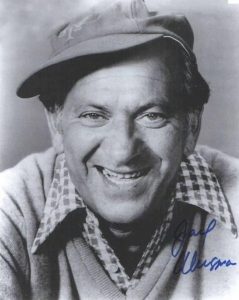 Oscar going against type, no matter how dependably funny, is bound to be hilarious because we know and love Oscar the slob: from the Mets cap atop his head to the mismatched shoes upon his feat. Likewise, finicky Felix taking on an Oscar-like characteristic has to be a scream. The gold standard of this personality swap, as anybody who celebrates New Year’s Day because it means Channel 55 in New York is running the Odd Couple marathon could tell you, is “I Gotta Be Me,” during which the roommates agree to act as each sees the other. In Felix’s case, that means he’s wearing the Mets cap. Less pronounced vis-à-vis the role-reversal trope is the episode “Felix the Horse Player,” when Felix finally sees what attracts Oscar to gambling and proceeds to become obsessed with doings at the track. Oscar going against type, no matter how dependably funny, is bound to be hilarious because we know and love Oscar the slob: from the Mets cap atop his head to the mismatched shoes upon his feat. Likewise, finicky Felix taking on an Oscar-like characteristic has to be a scream. The gold standard of this personality swap, as anybody who celebrates New Year’s Day because it means Channel 55 in New York is running the Odd Couple marathon could tell you, is “I Gotta Be Me,” during which the roommates agree to act as each sees the other. In Felix’s case, that means he’s wearing the Mets cap. Less pronounced vis-à-vis the role-reversal trope is the episode “Felix the Horse Player,” when Felix finally sees what attracts Oscar to gambling and proceeds to become obsessed with doings at the track.
Felix is convinced Oscar’s hot streak, enabled by tips he’s receiving from exercise rider Harry Tallman (Tallman is too short to be a jockey) is permanent and jumps on the betting train. Of course he turns obsessed and insufferable, even when Oscar tries to warn him away from betting it all on a horse called Yellow Angel, of whom Harry has advised, “I didn’t ride him, but he looks real good.”
FELIX: Yellow Angel in the third, it’s a sure thing.
OSCAR: No, no, I didn’t hear Harry say ‘sure thing’.
Natch, that wasn’t gonna stop Felix, who put aside “five dollars for socks” and indeed bet it all. It’s a sitcom, so you know Yellow Angel in the third wasn’t a sure thing.
Also, this is the Oscar’s Caps, our twelfth annual survey of the intersection of the Mets and pop culture, so you probably know we’re galloping somewhere with this…though not as swiftly as Yellow Angel approached the finish line (where the thoroughbred lost by “two lousy inches,” also known as a nose). Oscar cautioning Felix against interpreting “looks real good” as “a sure thing” sure sounds like an allegory for the 2023 Mets, but never mind them for now. I’m thinking about this very feature and all the information that goes into building it.
For example, if there’s a new movie titled Somewhere in Queens, chances are real good that I’m going to find out organically that it contains some Mets content. Yet I count five different friends of FAFIF who reached out to this blog to make certain we had on the record the following:
The trailer for the 2023 Ray Romano vehicle Somewhere in Queens included a man in a SANTANA 57 Mets t-shirt. When the movie was released, theatergoers indeed saw the shirt as well as prime signifiers that the movie is indeed set in Queens: a Mets cap, several small Mets pennants, a drive past Citi Field and an invocation of “Ya Gotta Believe”.
It was no sure thing I was going to know any of that. So thank you to everybody who dropped me a line to confirm that the Oscar’s Caps wouldn’t miss a Met trick in 2023. Same for all the other data that trickled in throughout the year, both for new stuff and old stuff that resurfaced. A person needs to consume a lot of popular culture to detect tinges of Metsiana, and no one person can be Endy Chavez and catch it all. Oscar’s Caps is particularly bountiful this edition because so many Mets fans are on constant high alert for shades of orange and blue showing up in unanticipated places.
When we first unveiled Oscar’s Caps at the end of 2012, we were thinking mostly in terms of TV, film, music, stage, works of fiction. In the ensuing years, we’ve experienced some mission creep. A Mets cap or a Mets jacket or a Mets reference seeps into non-sports real life where you wouldn’t expect to find it, we make a note of that as well. To not do so would go against type.
Thus, in addition to Somewhere in Queens dressing to fit its name, we have from the year past — and many years past — a slew of Amazin’ examples of Mets in the Pop Culture to add to our endless cataloguing.
***Jack Klugman as Henry Willows — we think we know him from another role — and John Stamos as Matt Willows drive by Shea Stadium on You Again?, Season 2, Episode 6 (“The Lush Life”), aired on NBC, November 12, 1986.
In Spidey Super Stories #8, the May 1975 issue, comic readers find Spider-Man going to Shea Stadium and wielding a Mets pennant as he shouts “Let’s Go Mets!” on what is framed as “Spidey’s day off,” firmly establishing our title character as a Mets fan. Alas, there’s no rest for a superhero as Spidey encounters The Wall, which is a villain you definitely wouldn’t want an outfielder running into let alone Spider-Man; in this story, it’s The Wall that runs into a Mets outfielder. Ouch! Spider-Man leaps into action, but ultimately, Spidey and The Wall are ejected from the field of play by the umpire, because baseball rules says only players can take the field.
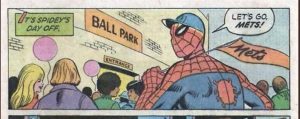
A framed Pete Alonso jersey-style crewneck sweatshirt has guest-starred on Diners, Drive-Ins and Dives on Food Network, which is to say it could be seen on the wall at Brooklyn’s Pies ‘n’ Thighs in an episode that aired on January 20, 2023. (It’s their sweatshirt that’s graced by ALONSO 20.)

Battle of The Bats —
Mets stick it to Cubs
—Tabloid newspaper headline tacked to Josh’s friend’s Billy’s bedroom bulletin board in Big, 1988
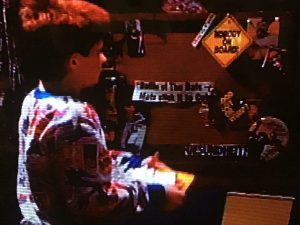
In the video for the Arcángel and Bad Bunny single “La Jumpa,” released in late 2022, Bad Bunny makes several appearances in a highly detailed long-sleeved shirt celebrating the Mets. The franchise’s home ballparks and world champions appear listed on the respective sleeves while NEW YORK and NY are prominent on the front.

***Oscar’s Caps doesn’t subscribe to a surfeit of streamers, but a cap must be tipped toward what Hulu seems to be doing to promote the greater good.
• In the first episode of Hulu’s 2023 History of the World, Part II, in a segment on the Russian Revolution (Fiddler on the Roof-style), a copy of the Nyet Post carries the front page teaser, “METS CONTINUE SLUMP!”
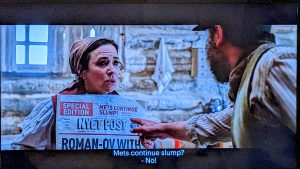
• In the 2023 Hulu series Up Here, Miguel (Carlos Valdes) wears a vintage 1986 National League East champions shirt.
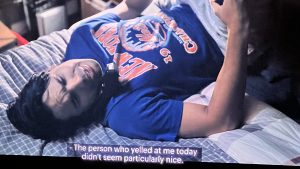
• On Hulu’s This Fool, “Clyde & Clyde, Parts 1 and 2” (Season 2, 2023), Rob Corddry, playing a cop in Los Angeles, puts on a Mets cap to convince a criminal he has just flown in from New York.
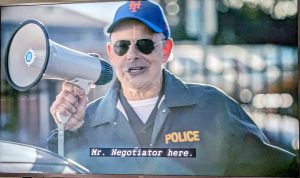
• And on Hulu’s How I Met Your Father, Season 2, Episode 13 (2023), Sophie may have spotted her father in the hot dog shop, watching a ballgame and cheering “Let’s Go Mets!” sparking an epiphany on Sophie’s part that she knows so little about the man who might be her father, thus scaring her off from confronting him with the possibility that they are indeed father and daughter. Another character says, regarding the man’s Mets fandom and the possible family ties, “That’s a brutal legacy to live with.” Come Episode 18, as she has dinner with the parents who supposedly haven’t seen each other since conceiving her. Sophie, in an effort to make her Mets fan father happy, asks the harpist she’s hired if she knows any songs about the Mets. ”I went to Juilliard,” is the harpist’s response.
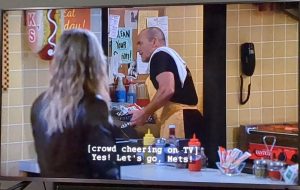
***When ABC celebrated the 50th anniversary of Schoolhouse Rock! on February 1, 2023, viewers were reminded that the very first educational vignette the revered Saturday morning series showed, on January 6, 1973, “Three Is a Magic Number,” featured an animated baseball team wearing uniforms that say “Mets” to get across the lesson that “3 X 9 is 27.”
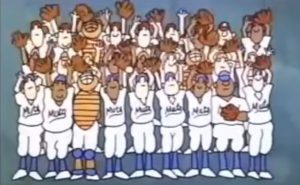
Spotted on the PIX11 Morning News in New York on February 6, 2023: Dancing with the Stars mainstay Val Chmerkovskiy in a Mets cap as he gave reporter Ben Aaron a few pointers.
“The theater with Miss Davenport, or the Mets against the Dodgers at the stadium?”
“How do we feel about that?”
“We suggest the Mets against the Dodgers, sir.”
—Gentleman’s gentleman Mr. French (Sebastian Cabot) helping gentleman Bill Davis (Brian Keith) arrange his social calendar in the series premiere of Family Affair on CBS, September 12, 1966
In the first episode of 2023’s Bill Russell: Legend documentary series on Netflix, viewers were treated to a glimpse of Tom Seaver chatting up Wilt Chamberlain. Tom Terrific interviewed Wilt the Stilt when Tom hosted Greatest Sports Legends in the late 1970s.
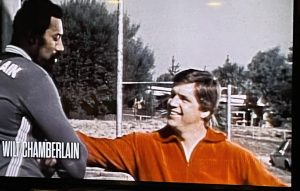
***From the non-explicit Mets pop culture sighting department:
In production in 2023: the movie You Gotta Believe, the story of a Little League team and not Tug McGraw’s rallying cry for the 1973 Mets.
“Teamwork makes the dream work.”
—Roman Roy echoing New York’s Dream Team’s 1986 hit song (“We got the teamwork to make the dream work…”), “Let’s Go Mets” in the series finale of Succession, “With Open Eyes” (Season 4, Episode 10), May 28, 2023
***On the game show 25 Words or Less, aired in early 2023, a contestant had to guess “Yankees,” and among the clues given — in the interest of economizing words — was “Baseball; not Mets…”
In Quiz Lady (2023), Jenny (Sandra Oh) wants a Philadelphia bar to switch its TVs away from the Mets and Phillies to the game show her sister Anne (real life Mets fan Awkwafina) watches regularly, a program called Can’t Stop the Quiz. In the televisions in the background of the scene, Taijuan Walker is pitching for the Mets at Citizens Bank Park with a 3-0 lead on April 11, 2022.
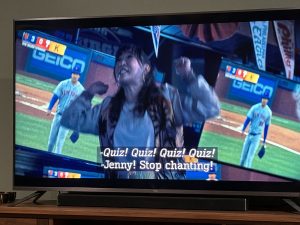
Speaking of game/quiz shows, this is Jeopardy!:
• “The kings of Queens, this team plays its home games at 41 Seaver Way in Flushing” was a clue on Jeopardy on February 16, 2023. When the contestant answered correctly, host Ken Jennings added, “Go Mets.”
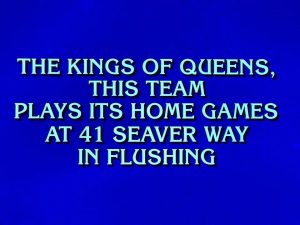
• On the April 14, 2023, episode of Jeopardy, the following clue was offered: “This Mets manager, Ol’ Casey, lost an argument on Marv Throneberry not touching 1st during a triple; turns out Marv missed 2nd too.”
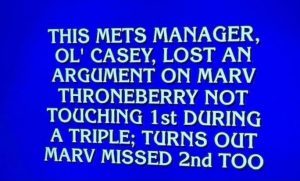
• On Jeopardy, May 10, 2023, contestant Sam Buttrey said he was a Mets season ticket holder who sold his ticket to Game Six of the 1986 World Series because he didn’t want to see them lose (but he did go to Game Seven).
• “Remember 1969, when these New Yorkers became the first expansion team to win a World Series?”
—$200 clue in the Remember Baseball category on Jeopardy, June 23, 2023
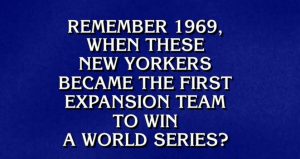
• On October 16, 2023, the 54th anniversary of the 1969 Mets winning the World Series, the Double Jeopardy answer on Jeopardy was “1969: Ed Kranepool, Bud Harrelson & Tom Seaver…What an Amazin’ Team”. (Category: “In the Baseball Team’s Lineup”)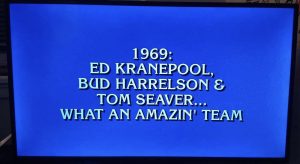
***You know who else besides Oscar Madison wears a Mets cap well? Mr. Met! And Mrs. Met!
Newark mayor Ras Baraka wore a Mr. Met cap while being interviewed on a local baseball field by an Eyewitness News Reporter (WABC-TV, Channel 7), May 5, 2023.

According to Stephen Colbert on The Late Show of January 19, 2023, Rep. George Santos’s claim that he used to attend the Met Gala was another lie from the Congressman — and that the only Met Gala that would want Santos might be the Mr. Met Gala.
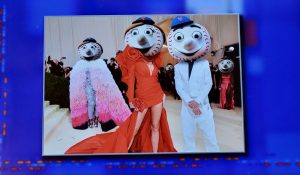
On the March 2, 2023, The Late Show with Stephen Colbert, the host expressed shock that a woman wearing a DeSantis t-shirt in a Florida diner on a Fox News segment told the reporter she was “either/or” when it came to Trump or DeSantis in 2024. “Either/or?” Colbert asked in mock shock. “You’re wearing a Ron DeSantis t-shirt. That’s like Mr. Met saying, “Go Mets! Or Yankees. I’m not really into baseball. This,” gesturing toward where Mr. Met’s large baseball-shaped head would be, “is just an unrelated medical condition.”
With the Westminster Dog Show’s 10th Anniversary Masters Agility Finals taking place at Arthur Ashe Stadium, just across the boardwalk from Citi Field on the first weekend of May 2023, you might have expected a Met presence, and had you, you would have been “ARF!”…make that right. Mrs. Met indeed welcomed the stylish pooches to the neighborhood. According to one witness taking in Fox Sports’ coverage of the proceedings, “There was a scene toward the end where Mrs. Met was shown bending down and petting one of the dogs, giving lots of love to her canine friend. Well, good for her, and I guess she might have walked there since it’s very close to her Mets team’s home stadium. Apparently, the dog was not freaked out by her disproportionately large head.”

On September 11, 2023, a drawing of Mr. Met was spotted on a Writers Guild of America picket line sign, outside the CBS New York facility where Drew Barrymore’s talk show was briefly being produced sans union writers, with a comic balloon expressing the mascot’s pro-WGA sentiments: “Be a Drew Carey, NOT a Drew Barrymore.” (Mr. Met could not be reached for comment.) Earlier, on August 8, Al Jean walked the WGA line in Manhattan while wearing an alternate-version Mets cap (white outline around the orange NY).
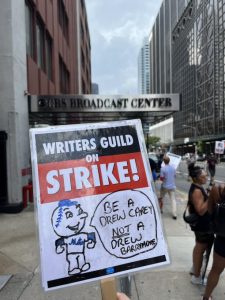
All Elite Wrestling (AEW) world champion Maxwell Jacob Friedman hyped his upcoming Grand Slam title defense at Arthur Ashe Stadium in September by visiting Citi Field in his personalized No. 55 jersey and reminding Mets fans he has always been one of them — with his bona fides showing most effectively when, during his interview with ballpark hosts Emily Reppert and Mike Janela, he praised Mr. Met as the only mascot that matters and called Chase Utley “a schmuck” (as if attendees didn’t already know that).
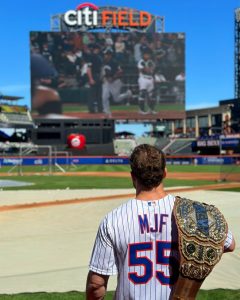
A September 2023 CNN news story that featured baseball mascots led anchor Jim Sciutto to let viewers know “Mr. Met is much better” than Screech the Bald Eagle from the Nationals (as if viewers didn’t already know that).
***The Hallmark Channel isn’t usually a stop on the Oscar’s Caps route, but we’re always willing to take a detour. From Hearts in the Game a Hallmark Original that first aired on April 29, 2023, we have…hoo-boy, what don’t we have?

Let’s start with the Mets cap on the driver’s side dashboard of a parked SUV on a busy street in Manhattan, or, given that it’s the Hallmark Channel, Vancouver as Manhattan.
Fred is the driver.
Jax is the assistant to Hazel, the person who is being driven and, at the moment, waited for.
Jax and Fred discuss a “big announcement” from Strike Zone Weekly — it looks like the New York Mets have “officially lost their minds” as rumors spread that they are signing pitcher non grata Diego Vasquez.
Who is Diego Vasquez? Exposition tells us, “The league’s top pitcher was dropped last season for freezing on the mound in the ninth inning of Game Seven of the World Series, and Vasquez still won’t comment on why. In our humble baseball opinion, this could be Vasquez’s last chance at pitching professionally.”
FRED: I don’t know what the Mets are thinkin’. A guy that freezes like that is not New York Mets material. We are a team that cares about tradition, loyalty!
JAX: He’s one of the best pitchers Major League Baseball has ever seen. Vasquez holds the record for the most no-hitters in baseball history, and that’s exactly what our Mets need, Fredo!
FRED: I sure hope the Mets know what they’re doin’, ’cause they’re bettin’ the entire franchise on Diego Vasquez.
JAX: That’s the beauty of baseball — the theatrics, the heart, the soul!
Soon we hear from Mark Gold, Vasquez’s agent, giving the straight skinny to the would-be Amazin’:
“We’re gettin’ pressure from the GM to make sure you look good. The New York Mets club doesn’t really trust you yet. The Mets won’t make it official until we start to see some good press.”
The aforementioned Hazel is a PR wizard who has a chance to take on Vasquez as a client (and maybe more?). Hazel is reticent, but Jax is insistent:
“You could change the fate of baseball, the fate of the New York Mets, and as a diehard Mets fan, I can tell you that if we ever wanna win, the New York Mets must commit to Diego Vasquez, you must commit to Diego Vasquez.”
Hazel and Diego do get together, professionally, but there are twists and turns on the road to getting the pitcher that “good press” the Mets demand before they dare sign the holder of the record for most no-hitters in baseball history. An article Hazel has planned for Hudson & Park magazine appears to be off. She has to break the news to Jax.
HAZEL: How would you feel if I did the right thing, but that [means] the New York Mets may never win again.
JAX: If it means your happiness, I would literally love nothing more in the world, Hazel.
HAZEL: Even over the Mets?
JAX: Even over the Mets, which is hard.

Hallmark’s imprint ensures Hazel and Diego get together more than professionally. We are eventually transported to “New York City Months Later,” indicated by the exterior of Citi Field from the air and a closeup of the ballpark’s logo. Inside, Diego is at a press conference table set up in front of Mets, MLB and Citi Field logos. Vasquez sits in a blue Mets cap with black long sleeved shirt that has the blue NY logo. He fields a reporter’s question:
“Mr. Vasquez, what a comeback. A no-hitter in your first professional game back. How do you feel?”
“I feel great, I feel really great.”
When asked in a razor-sharp followup, after it’s been acknowledged that it’s been quite a year, “how are you liking New York?” Vasquez minces no words:
“It feels like home, it really does.”
Congratulations to the New York Mets on their third no-hitter.
***The Simpsons, Season 34, Episode 19; April 30, 2023; “Write Off This Episode” starts with a sports gambling commercial in which Coach Jim “Jimmy” Jimmerson tells viewers, “In the sport of sports betting, you’ve gotta sport bet responsibly,” and on a blackboard, one of Jimmerson’s 3 Simple Rules to follow is “Mets, Jets and Nets = Debts”.
On the Season Three premiere of Comedy Central’s Awkwafina is Nora from Queens (April 26, 2023), Nora’s dad Wally buys coffee at a coffee cart operated by a guy wearing a Mets cap.
“I want a contract that guarantees me an expense account, stock options, 22 weeks vacation, a company car, a box at Shea Stadium, a percentage of the gross, total creative freedom, transplant insurance, and a no-cut clause.”
—Nathan (Stan Gottlieb) listing his demands to stay at the newly named Truth and Soul advertising agency, Putney Swope, 1969
In the 2022 documentary “The Princess,” archival footage contrasting British civil unrest with the nation’s excitement over the 1981 engagement of Charles and Diana includes a person in a Mets cap smiling incongruously next to an aggrieved woman shouting into a microphone, “Our children are suffering!”
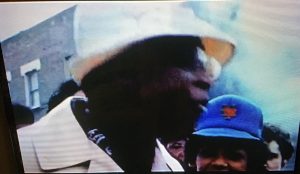
“What do you think about him?”
“Who?”
“Gil Hodges. I mean, can you explain to me how anybody in their right mind would get rid of Gil Hodges?”
“Well, I suppose that’s all in the point of view.”
“Precisely, absolutely. You’ve got a good mind, young man, an extremely good mind.”
“Thank you.”
“It’s the top of the sixth. The Giants are leading the Mets, six to two.”
“Excuse me a minute. He’s out.”
“Who?”
“Gil Hodges.”
—Exchange between shopkeeper Sadie (Doro Merande) and customer/television writer Julius (Jack Weston) in a bookstore, where a radio is playing a ballgame that the announcer has said is already in the bottom of the sixth. Indeed Gil Hodges is batting (and Jack Sanford is pitching) after Willie Mays has made a basket catch…in The Twilight Zone, “The Bard” (Season 4, Episode 18), first aired May 23, 1963, the very day Hodges was traded by the Mets to the Washington Senators to become their manager
In a May 25, 2023 NBC Nightly News report on the struggles facing America’s Chinatowns, New York’s historic community was represented by Cory Ng, proprietor of the Potluck Club restaurant, with Ng, in turn, choosing to rep the Mets in his nationally telecast interview with correspondent Vicky Nguyen. Cory wore a black Mets cap with the 2000 Subway Series logo on the side as he explained how important preserving the culture of Chinatown is to him.

In The Marvelous Mrs. Maisel, Season 5, Episode 3, “Typos and Torsos” (2023), we are transported to Toots Shor’s in 1961, where fictional talk show host Gordon Ford and actual sportswriter Jimmy Breslin are having a chat in which Breslin tells Ford that New York is a baseball town.
BRESLIN: The Pirates are gonna repeat. It’s not what I want, but it’s what’s gonna happen.
FORD: No, it’s gonna be the Yankees.
BRESLIN: Without Stengel?
FORD: Good riddance to Stengel. Don’t quote me on that.
BRESLIN: Word is he’s talking to the Mets.
FORD: The Mets? What’s the Mets?
Breslin proceeds to laugh, perhaps knowing it will be up to him (and Stengel) to define them in 1962.
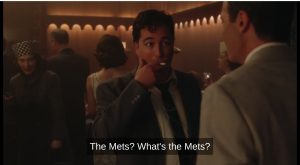
***More than a few cross words were spoken about the Mets in 2023. And more than a few New York Times crossword puzzles were filled in with Metsian answers.
April 19, 2023 NYT Crossword, 5 Down: ____ Field (Shea Stadium successor) — four letters … CITI
April 22, 2023 NYT Crossword, 65 Across: Piazza, for one — five letters … EXMET
April 30, 2023 NYT Crossword, 30 Down: New York’s ____ Field — four letters … CITI
May 14, 2023 NYT Crossword, 79 Down: Queens Players — four letters … METS
May 25, 2023 NYT Crossword, 57 Down: National League expansion team of 1962 — four letters … METS
June 11, 2023 NYT Crossword, 14 Down: Team seen in Queens in brief — six letters … NYMETS
June 18, 2023 NYT Crossword, 5 Across: Citi Field mascot — five letters … MRMET
August 14, 2023 NYT Crossword, 69 Across: Citi Field team — four letters … METS
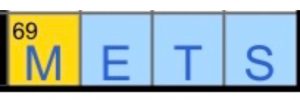
November 7, 2023 NYT Crossword, 1 Across: N.L. East team for which Tom Seaver pitched — four letters … METS
November 16, 2023 NYT Crossword, 16 Across: N.L. East team — four letters… METS
December 12, 2023 NYT Crossword, 68 Across: Baseball’s Alonso or Rose — four letters … PETE
December 17, 2023 NYT Crossword, 77 Across: Former M.L.B. left-handed pitchers Jackson and Leiter — three letters … ALS
For those who ventured beyond the long-established wordplay on nytimes.com, on October 5, 2023, the New York Times Connections game, in which players attempt to thread sixteen given words into four groups of four, “MET” went with “ANGEL,” “CUB” and “RED” in the category “M.L.B. Team Member”. (“NAT” was another choice, but that was an answer within the category “Insect Homophones”).
Yet if you were looking to stay up to date on your favorite baseball team, or any baseball team, the Times ceased being the paper for you by September, when it altogether dropped the sports section that was already a shadow of its former self. Between Opening Day and the All-Star break of 2023, a search of nytimes.com for articles containing “Mets” and “Showalter,” a decent indicator of day-to-day reporting on one of the paper’s ostensible hometown teams, turned up in all of 14 articles despite manager Buck Showalter’s Mets having played 90 games to that point while making plenty of news. Although the New York Times had long ceased daily coverage of its hometown National League team by 2023, they did manage to find their own Amazin’ angles in their non-sports reporting.
Since the Times was no longer a newspaper that covered sports, it seems Oscar’s Capsworthy to note how they got the Mets into the paper, beyond four-letter clues.
On June 27, 2023, the Times visited with drag king/actor Murray Hill as he received the star treatment at Citi Field on Pride Night. “I’m a sports guy,” Hill said, even though he referred to the ballpark as “Mets Stadium”.
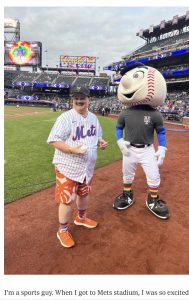
In the Mini-Vows section on June 30, 2023, NYT readers got to know Elan David Cooperman and Sydney Marissa Berger, portrayed as a sports-mad couple who reached a crossroads before they could take the biggest step of all:
“Ms. Berger had grown up in a split household: Her mother rooted for the Yankees, while her father was a Mets fan. Out of loyalty to both parents, she had never picked a side. On their first date, Mr. Cooperman, a diehard Mets fan, told Ms. Berger that ‘if this is going to go deep, you’re going to have take a side.’ She went all-in for the Mets,” as evidenced by the presence of “two special guests joining the party: Mr. and Mrs. Met, the official mascots of the New York baseball team, strutting into the celebration. ‘When they came in, our jaws dropped to the floor,’ Mr. Cooperman said.”
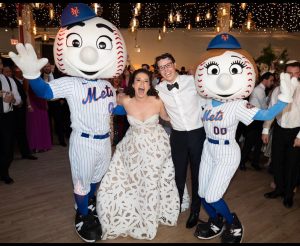
Come July 6, 2023, Op-Ed columnist David Brooks devoted one of his pieces to musing about his Mets fandom: “I’ve lived my fan life in a state of irrational anticipation.” Four days later, it turned out any fan of any team would be irrational to anticipate the Times sports section being part of the paper much longer, as the so-called Paper of Record announced it was disbanding its sports department, explaining it would lean on the NYT-owned (and non-union) Athletic — where at least national baseball columnist Tyler Kepner was able to transfer his talents — for “coverage of teams and games”. The Athletic does a helluva job. But so did the Times in its heyday.
While the Times no longer seemed too interested in sending its own reporters out to Citi Field to track the ups and downs of the Mets, plenty of photos from the ballpark were published on July 14, including one of a woman in a bootleg t-shirt that combined the Mets logo with that of a timeless band, to illustrate a story on the final tour of Dead & Company, which had stopped over in Flushing a few weeks earlier.
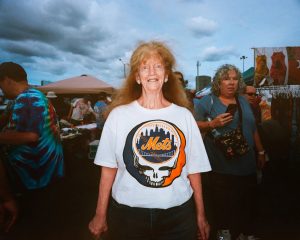
Following the implosion wrought by the 2023 trade deadline, Times music writer and Mets fan Lindsay Zoladz on August 4 offered subscribers to The Amplifier newsletter “a (sad) playlist for the 2023 New York Mets,” fifteen songs ranging from the obvious to the obscure, explaining, “As any librettist or opera composer knows, some tragedies are so grand that they must be expressed in music.” Selections included Peggy Lee’s “Big Spender” for Steve Cohen; “Come Back From San Francisco” by The Magnetic Fields, dedicated to former Mets Michael Conforto, J.D. Davis and Wilmer Flores; “June Is As Cold As December,” an Everly Brothers track recalling the month when the Mets fell out of contention; and “New York Groove,” Ace Frehley’s jam that scored the increasingly rare home team win at Citi Field.
In that spirit, a quick playlist of our own, in memory of the sports section of the Times from when it was truly in the New York groove:
“The announcement this week that the New York Times comes as the kind of shock you get when you turn a corner and a longtime store or restaurant or building is gone; even if you haven’t been there in years, it takes a moment to wrap your head around a world without it. I grew up a sports fan in a New York Times household. In the ’70s and ’80s this meant waiting days for box scores to appear. Everything about the sports section reinforced the idea that sports really wasn’t that important in relation to the rest of the paper, or the world. I always got the sense that this was grown-ups writing about sports for grown-ups. A serious and un-fun paper with no comics or pulp, it seemed fitting to me that they had a columnist named Ira.”
—Alex Belth, Esquire
“I think it’s important, when talking about the Times sports section, to talk about the unique place sports has within that particular paper over the years. It’s almost like Times sportswriters worked for what the country’s most essential newspaper considered to be its least essential section. This is what the paper thought, right? […] At one point in history, it seems weird now, the New York Times was a New York newspaper. It was being read by people across the country, but it was also like, ‘We have local teams here we need to cover.’ That’s the base function of any sports page, covering the local teams. So they did that for a while. Slowly they pulled away from that, probably as they became a national paper and the world was really changing, and said, ‘OK, what if we don’t have to cover the Yankees and the Mets every day?’ Remember, New York has tons of sports teams, so in order to do that, it’s just a lot of manpower. ‘What if we become a more nationalized section?’ […] It felt like it was programmed for people that were reading the rest of the Times to come over, ‘and here’s a sports feature that’s going to interest you, but it’s not going to be something that’s gonna be a sportsy sports piece that you’re not gonna care about.’ I just don’t know how many of those people exist.”
—Bryan Curtis, The Press Box podcast
“As Times writers and editors, we had to be better than everyone, not just because our readers expected it, but also because our disapproving bosses were always lurking. I remember my welcome lunch when I was hired in 2003, a group of new hires invited to then-publisher Arthur Sulzberger’s office. As he asked all the others about their careers and their interests and what they hoped to accomplish, his only question for me was how I thought the Giants might do that season. My spot at the bottom of the Times totem pole might as well have been monogrammed, but at least my introduction to it came with a nice salad. The dilemma that predated me, and lasted beyond my departure in 2014, was never solved. No one ever figured out how to keep everyone happy: sports fans who wanted all the details, the daily grind of games and practices and melodramas; and a set of bosses who couldn’t care less about any of that. For years, we gamely did both: covered the sports as sports people expected and also wrote huge, award-winning pieces and series and covered big, tough topics like the concussion plague, the Boston Marathon bombing and all the other big social issues that always end up intersecting with sports.”
—Lynn Zinser, Editor & Publisher
“From my standpoint, this has been coming on for a long time, since people stopped reading newspapers – a terrible trend for swaths of the country that no longer have the information to cope with government and business and health issues. When I see once-great papers like the Louisville Courier-Journal get Gannetized, my heart breaks. The sports sections were particularly vulnerable. While I was still working, valued colleagues, particularly sports columnists, began to be disappeared, sometimes en masse. Fortunately, the New York Times made a lot of good decisions — a web presence, color in the paper, and more valuable news and information about health and safety and cooking. Perhaps the best business decision was to use the sparkling printing plant in College Point, Queens, to print other newspapers. The Times now prints 60 papers, from dailies to weeklies, news and ethnic. That pays some bills around the paper. Since I retired at the end of 2011, the Times has flourished around the country and around the world, using other print plants. However, deadlines had to conform, with available press time, which ultimately meant the Times had to stop covering games — Mets games, Yankee games, Giants games, Jets games, etc. To its credit, this great paper continued to report and comment about the major issues in sports — brain concussions, how money was made and spent, gender issues, racial issues. Inevitably, the excitement over the ‘local’ teams was lost. I felt the absence of emotion. Readers felt it. […] Readers feel there is a hole in their lives. I can tell you about my sense of loss of the Sports Department — once a bustling clubhouse of colleagues, specialists, who schmoozed and kibitzed across their specific skills. They formed a team.”
—George Vecsey
***On Saturday Night Live, April 1, 2023, in the Please Don’t Destroy Street Eats video, Martin Herlihy as “Tabby Cat” wears a Mets cap as part of a crew of three overconfident, clueless post-college guys who visit a jerk chicken store in Jamaica and a (mispronounced) bodega in the Bronx in their quest to get a taste of real New York food.

Two other appropriate SNL fashion statements:
• Host Pete Davidson wore a Mets jacket when he appeared in promotional spots for the 2023-24 season premiere of Saturday Night Live (Season 49).
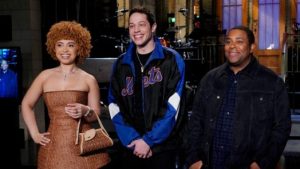
• In the official Saturday Night Live cast photo for Season 49 (2023-24), Michael Che, holding down the center spot in the back row, wears a Mets cap (along with a Knicks jacket).
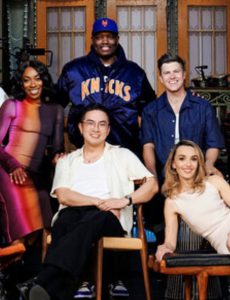
From when the Mets were at their most fashionable, in his first appearance as “Mr. Subliminal” — the recurring sketch in which almost imperceptible hints regarding what he wanted or wanted thought were dropped into conversation — Kevin Nealon several times quickly mentioned “Mets tickets” to his boss, played by Jon Lovitz, on the Season 12 premiere of Saturday Night Live. Not surprisingly, Lovitz gave Nealon Mets tickets. Also not surprising: this episode aired October 11, 1986, hours after Lenny Dykstra’s walkoff two-run homer gave the Mets a two-one lead in their NLCS versus the Astros, making an even hotter commodity out of Mets tickets (even if there was little subliminal to Dykstra’s persona).
Saturday night, especially on NBC, inevitably leads to Sunday morning, especially on CBS:
• On CBS Sunday Morning, March 12, 2023, in advance of that night’s Academy Awards presentation, Josh Seftel, director of Stranger of the Gate, nominated in the Best Documentary Short category, spoke with his mother about his chances of winning an Oscar. She reminded her son that an award would be a “feather in your cap,” but that “you’ve already got the cap.” When he asked her, “What kind of cap is it?” she replied, “baseball cap,” with a picture of Josh in a Mets cap appearing to end the segment. (Josh’s film did not win).

• “One man has a rich, fulfilling life, and the other is a dad.”
—Comedian Jim Gaffigan’s Father’s Day essay on CBS Sunday Morning, June 18, 2023, illustrating his own dad life with a picture of himself with his children all in Mets caps at what appears to be the Grand Central 7 station, presumably going to or coming from a Mets game (Gaffigan is smiling; the kids are…not quite).
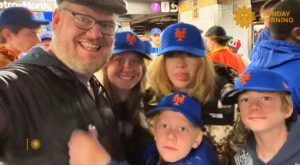
The legacy of David Letterman is shared by the Eye and the Peacock. Here’s a Metsian taste from each of the great man’s after-dark programs:
On March 31, 2011, on the eve of Opening Day, Chris Rock visited The Late Show with David Letterman to bemoan how cash-strapped the Mets were in the wake of the Bernie Madoff mess. “My team’s broke, Dave,” the comedian told the host. “Some teams don’t have a cleanup hitter, some teams don’t have a closer or a good pitcher. My team has no money, Dave.” When Letterman asked Rock if he had season tickets, Rock replied, “They don’t have tickets no more, Dave. No more tickets — tickets cost money, they’re on paper, they have no paper, Dave. You show up and a dog licks your hand, then you show the spit and they let you in. This year, second base is a manhole cover, Dave. Between every inning, they use the other team’s gloves. No catcher’s mask this year. They just get an ugly guy. The Yankees got Bat Day. The Mets got Bring a Bat Day. ‘Here ya go, Jose Reyes. My daddy gave me this for Christmas. Maybe you can use this.’ It’s gonna be some year.” (The Mets would go 77-85 in 2011, their first season under Terry Collins.)
“Why is it so hot in here?”
“Because the Mets won.”
“So this building is on the same circuit as Shea Stadium?”
—Exchange between David Letterman and an offstage voice, Late Night, October 14, 1986, following the Mets’ 2-1 victory over the Astros in Game Five of the NLCS
***Oscar’s Caps admires unlikely entities doing their best to understand the Mets. We’d place John Wilson, the host of HBO’s How To with John Wilson, squarely in that category. In “How to Watch the Game” on How To with John Wilson, Season 3, Episode 4 (August 18, 2023), John — very much not a sports fan — receives an email from the PR department at Citi Field inviting him to a game toward the tail end of the 2022 season.
Even though the email is directed to “Josh” Wilson, John accepts.
To make sure he fits in, he stops by a Times Square souvenir shop to purchase a Mets cap; as he buys it, he confirms that it is indeed a Mets cap.
For research, he looks up the Mets’ Baseball-Reference page and scrolls through some other material, including the Posts’s Mike Piazza “I’M NOT GAY” back page from 2002.
When he arrives at the ballpark for “quality time at Citi Field,” he’s is very much a stranger in a strange land, and that strange land is deluged by rain. He passes a couple of college-age fans — one whose shirt bears Greek fraternity letters — and asks, “What do you think’s gonna happen?” The answer: “Mets gonna lose.” John’s reply, “Ah, shit.”
Viewers see Citi Field personnel wiping down the fanciest seats (John seems to think this happens throughout the ballpark whenever it rains; it doesn’t) and John’s camera shows us another staff member wearing an ALCOHOL COMPLIANCE jacket, which John takes to mean he “makes sure people drink enough alcohol”.
We’re also treated to a glimpse inside the media dining room, where John marvels that there’s a meat loaf large enough to feed all “the male photographers”.
Eventually, the show’s host bumps into loyal Mets fan and Citi Field fixture Pin Man, Nicholas Giampietro, who invites John to his house once the game is rained out. Pin Man — whose jersey identifies him by nickname and is festooned with pins — graciously pulls out his ’86 Mets video tape A Year to Remember to bring John up to speed on Mets history.
In one final admission of unfamiliarity with his subject matter, John asks Pin Man, “Was the ’86 team a good team?”
***Oscar’s Caps admires likely entities continuing to be Metsie as hell. On December 8, 2023, for the second night of Yo La Tengo’s 2023 annual run of Hanukkah shows at the Bowery Ballroom, the guest mix CD provided to raise funds for charity (in this case Doctors Without Borders) was compiled by Howie Rose, with the music therein a collection of songs from Mott the Hoople. No explanation is needed in these quarters what legend Yo La Tengo named themselves for (but maybe a certain “news” outlet requires a quick refresher on which Frank Thomas is which Frank Thomas).
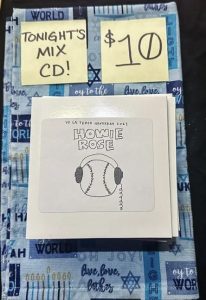
Right up there with YLT and Oscar Madison’s cap itself is the most cornucopic of post-Odd Couple Mets pop culture content, Seinfeld. If there’s a sure thing in our world, it’s that every Mets fan reading this knows about the Keith Hernandez episode. Yet there’s always more to learn about any subject.
• On May 5, 2023, Noah Gittell on defector.com examined Seinfeld’s unwelcome shift in baseball focus from the Mets to another New York baseball team, noting not only most of the Mets-intensive plots (most notably “The Boyfriend” with Keith Hernandez), but how “whenever possible, Seinfeld incorporated Mets imagery into the show. In ‘The Busboy’ (June 2, 1991), the title character has a Mets banner above his bed. ‘The Alternate Side’ (December 4, 1991) opens with George wearing a Mets cap, complaining about Jerry’s being stolen, as they return to Jerry’s apartment. We can presume that they were on their way to Shea Stadium.” Gittell bemoaned that once George got a job as assistant to the traveling secretary fro the Yankees, “the Mets virtually disappeared from the show, while their cross-town rivals became fully integrated into the group’s weekly hijinks.”
• Come August 23, 2023, New York magazine’s Vulture section included a Q&A between Devon Ivie and Keith Hernandez in which “Keith Hernandez Answers Every Question We have About Seinfeld,” with Keith revealing, “I’ve only watched the episode a couple of times. I have a hard time watching it, so I haven’t in several years. […] I feel like it’s embarrassing to me. I don’t think I did that great a job.” Keith also forgives George Costanza for joining the dark side: “It’s all part of creativity and comedy. They had to think about all the episodes. The writers had to come up with different storylines every week. It’s a lot of pressure.”
Keith’s a very understanding person.
***“Casey Stengel doesn’t have half the problems I have.”
—Charlie Brown, upon discovering Snoopy is standing at his position asleep, May 28, 1964 (with the Mets off to another terrible start)
“NEW CANAAN, CT—Sources familiar with the man’s role in his child’s life confirmed to reporters Monday that local dad Marcus Weir’s parenting strategy is solely focused on ensuring his son doesn’t become a New York Yankees fan. Beginning shortly after his son Miles’ birth nine years ago, Weir reportedly concentrated the entirety of his fatherly influence on making the boy a supporter of any sports team besides the Yankees, a project he initiated by acquiring several Mets onesies in his son’s infancy.”
—From the Onion, “Dad’s Entire Parenting Strategy Just Ensuring Son Doesn’t Become Yankees Fan,” May 27, 2023
At the very end of the June 9, 2023, episode of The Prestige TV Podcast (a Ringer production), in which host Sean Fennessey interviewed star and creator Bill Hader regarding the series finale of Barry, Hader blurted out, “Go Mets!” presumably as a friendly nod to Fennessey’s fandom. Sean’s response was, “That’s just mean.” Fennessey, on Twitter, referred to Hader’s remark as trolling; Hader is an excellent actor, so perhaps “Go Mets!” wasn’t as sincere as one wished to believe it sounded. Though the podcast episode was taped in advance, it dropped shortly after the Mets were swept by the Braves in Atlanta, the last game of the series lost, 13-10, in ten innings.
“If you don’t have a philosophy, you turn into the Mets, and I’m a lifelong Mets fan.”
—Brendan Sweeney, KUOW-FM, a public radio station in Washington state, describing for the Nieman Journalism Lab in a November 2023 article the challenges his medium faces; in the words of author Ben Brock Johnson, Sweeney added, “The Mets survive via the largesse of a wealthy benefactor, but don’t have a lot of pennants.”
A distant shot of Mark Canha playing left field at Citi Field graces the cover of the July/August 2023 issue of The Atlantic, illustrating Mark Leibovich’s cover story, “Moneyball Broke Baseball,” about the implementation of the pitch clock.
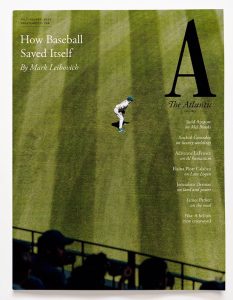
On October 23, 2023, in the single-panel comic strip The Lockhorns, Loretta Lockhorn informs another couple that grumpy-looking Leroy Lockhorn “hates the new pitch-clock rules…it means less time for him to drink beer,” and she does so in the parking lot of a gray edifice that is very much modeled on the dear departed Shea Stadium, a mere fifteen years since it last hosted a ballgame.
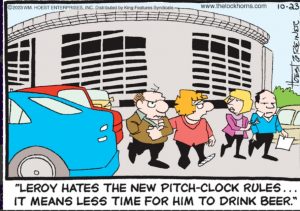
John Mayer wore a LINDOR 12 Mets shirt as he performed with Dead & Company at Citi Field on June 22, 2023, with Francisco Lindor and wife Katia Reguero Lindor in attendance, tweeting the next day, “I’ll never forget those two NYC plays at @citifield,” identifying as his “Series MVPS: @lindor12bc for his friendship and hospitality, and the @mets organization for taking such wonderful care of me and one of their biggest fans: my dad.” Father and son showed off their vintage Cooperstown Collection Mets jackets in said tweet.
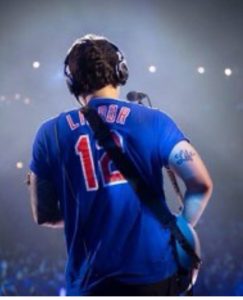
Actress Chloë Grace Moretz throwing out the first pitch at Citi Field on August 7, 2023, prior to that night’s Mets-Cubs game, earned notice as one of “The Best Celebrity Wellness Instagrams of the Week” by SELF magazine later in the month.
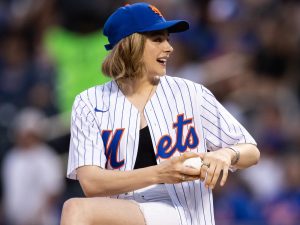
Among the many talking heads in the 2023 HBO documentary Albert Brooks: Defending My Life, only Judd Apatow thought to wear a Mets t-shirt (featuring a prominent orange NY) as he shared his thoughts with director Rob Reiner.
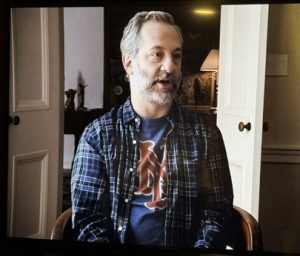
Sadly, the world of Mets pop culture lost one of its implicit advocates in the past year, as Young Capone, a rapper who performed while wearing a Mets cap, died in August 2023 after having been reported missing for several weeks. He was only 35.
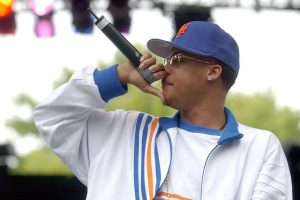
***In the first episode of the second season of the Netflix series Atypical (2018), Doug, portrayed by Michael Rapaport — before he showed up on SNY between every half-inning to promote Mike’s Amazing Mustard — is shown in a flashback to 2004, during which he wears a Mets cap.
At the Congressional Hispanic Caucus Institute (CHCI) Leadership Conference in September 2023, Vice President Kamala Harris shared a stage with Mets superfan John Leguizamo…and Leguizamo represented as he so often does, wearing a Mets cap for the occasion.

In the 2014 documentary Advanced Style, one of the Manhattan-based fashion icons profiled, Tziporah Salamon, jokes to her doorman, “Coco Chanel would never be taking the subway,” while she brandishes a Metrocard…but not just any Metrocard. Ms. Salamon is holding a Metrocard with a Mets logo printed on its underside, plainly discernible to the viewer, assuming the viewer is forever on the lookout for even the most incidental Met sightings in the popular culture.
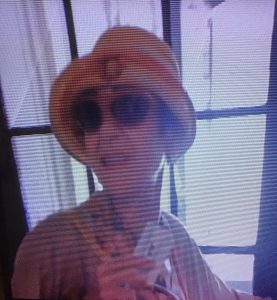
Enchanting iterations of “Meet the Mets” are a staple of every season, good or bad. In 2023, Jordan Simpson dropped his jazzy version, accompanied by a Spotify video in which he shows off not just his musical talents, but an impressive array of Mets jerseys.
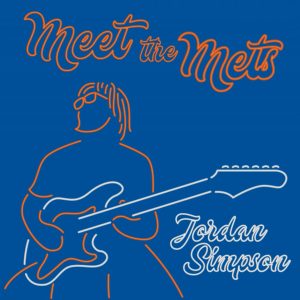
In the 2023 installment of the PBS series American Masters on Jerry Brown (“The Disruptor”), a clip from Brown’s 1992 presidential campaign reveals one fellow in a Mets cap. Much as the 1992 Mets failed to attain their goal, Brown did not win that year’s New York primary.
In 2023, the same year he learned the Mets would retire his number in a Citi Field ceremony the following season, Darryl Strawberry was featured in the documentary, The Saint of Second Chances, the story of Mike Veeck. Their paths crossed in St. Paul in the mid-1990s when Darryl revived his then-dormant baseball career by playing in the Northern League for the unaffiliated Saints, run by Veeck.
Before the Strawman was in need of the a second chance, the December 1987 issue of Spy magazine, splashed its popular “Separated at Birth” feature on its cover, with two subjects suggested as sharing DNA Darryl Strawberry (in Mets cap and jacket) and Dino from the Flintstones (in a non-team baseball cap). The resemblance was striking.
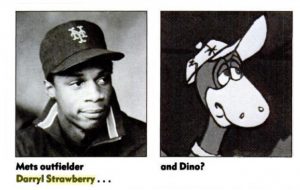
Vincent D’Onofrio as Steve Cohen wears a Mets cap in Dumb Money, 2023’s cinematic telling of the GameStop caper.
The ubiquitous GEICO Gecko stands at home plate and speaks into a microphone (ostensibly to tell a joke that is drowned out by a flyover) at what is clearly a CGI’d version of Citi Field in an insurance commercial that ran on national telecasts during the 2023 postseason.
A TMZ Live correspondent wore a Los Mets cap (made by The 7 Line) on camera on November 16, 2023.
In the 2001 time-travel romcom “Kate and Leopold,” the actor brother of Meg Ryan’s character (Kate McKay) is watching a Mets game, with Mike Piazza at bat. The brother, Charlie, played by Breckin Meyer, starts calling the action using different accents. When Mike hits a home run, the brother describes it in an Indian accent similar to that of Apu from The Simpsons (itself considered culturally insensitive in later years, even if it is a creation of celebrity Mets fan Hank Azaria…and Apu’s favorite squadron is the Nygh Mets). In addition to game footage, the moviegoing audience was treated to a glimpse of a framed poster featuring the Mets skyline logo and several of the 1969 Mets — their heads floating in circles — above the words LET’S GO METS as it appeared in the apartment of Liev Schreiber’s character (Stuart Besser, Kate’s ex).
On October 15, 1978, a Mets pennant was visible in a sketch performed by Bob Hope and Steve Martin (as ballpark vendors) on Bob Hope’s All-Star Comedy Salute to the 75th Anniversary of the World Series on NBC, as close as the 1978 Mets were getting to the World Series.

The 1980 “America’s Turning 7 Up!” commercial that starred three National League East superstars — the Cubs’ Bruce Sutter, the Pirates’ Dave Parker and the Phillies’ Mike Schmidt — also included, essentially as a prop in the Schmidt segment, a forlorn catcher whose jersey’s blue and orange trimming around its short sleeves very much suggested a Met backstop helpless to stop his division rival from a) tapping on home plate with his bat to produce a bottle of the sponsor’s product on demand and b) whacking another home run.
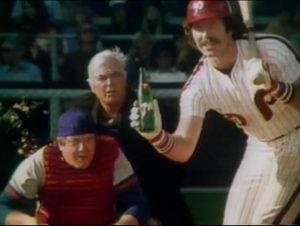
***As a guest of Adam Schein’s on SiriusXM’s Mad Dog Radio on May 24, 2023, new Jets quarterback Aaron Rodgers said he got an idea of how “special” winning a championship in New York would feel like from watching 2021’s Once Upon a Time in Queens, the four-part 30 for 30 documentary that revisited the exploits of the 1986 Mets. The 39-year-old Rodgers mentioned having been a Kevin Mitchell fan growing up in Northern California.
Aaron Rodgers was going to be a big deal in New York in 2023, remember that? Well, maybe in 2024. If you’re not necessarily looking forward to that guy, you can look forward to the following flowing from the pens of a couple of true orange-and-blue storytellers:
• May 2024 will see the release of the novel Curveball, which will follow lefty hurler Jess Singer, who author Eric Goodman explains “will start the year at Syracuse, but make it to Flushing after the Super Two deadline”. Curveball is the sequel to the 1991 book In Days of Awe, which introduced readers to Jewish Joe Singer, “a pitcher for an unnamed National League team in Queens”. Goodman, in case you haven’t inferred, describes himself as a “lifelong Mets fan” who “grew up in Brooklyn and saw them play at the Polo Grounds”.
• The new year will also be graced by the release of the sixth Mike Stoneman thriller, Double Takedown, set in September of 2023. When the title detective “turns on the TV to watch the Mets game,” author and diehard Kevin Chapman warns readers, “it isn’t pretty.”
We look forward to those books, and we also anticipate seeing, reading, hearing and discovering Mets Pop Culture that has yet to see light and Mets Pop Culture that emerges from dark corners of the collective consciousness. Again, enormous thanks to everybody who helps keep Oscar’s Caps current and comprehensive.
|
|
 The end of the first act, where you introduce the superstar — unorthodox for timing, but effective. It might have worked better if you could have had him from the beginning of the story, but once you work him in there, he’s a blockbuster unto himself. We’re gonna put him on the posters and everything.
The end of the first act, where you introduce the superstar — unorthodox for timing, but effective. It might have worked better if you could have had him from the beginning of the story, but once you work him in there, he’s a blockbuster unto himself. We’re gonna put him on the posters and everything. We like some of the supporting cast. The first baseman, for example, is a natural. The hard hat he wears everywhere is supposed to be what, his trademark? Whatever it is, it’s unique. We think it might test well. His hitting you shouldn’t change at all.
We like some of the supporting cast. The first baseman, for example, is a natural. The hard hat he wears everywhere is supposed to be what, his trademark? Whatever it is, it’s unique. We think it might test well. His hitting you shouldn’t change at all. The rest of the infield is…interesting. Listen, we love the scenes where the shortstop fields. Those test off the charts. Well worth the special effects budget that I assume is needed to make him fly through the air. Could he be made into more of a hitter, though? Something to think about. His friend the third baseman plays well in his role, but we hear he has some versatility, and you might want to try him in the part of the second baseman. Nothing wrong with him at third, mind you, but we absolutely have to recast the second baseman.
The rest of the infield is…interesting. Listen, we love the scenes where the shortstop fields. Those test off the charts. Well worth the special effects budget that I assume is needed to make him fly through the air. Could he be made into more of a hitter, though? Something to think about. His friend the third baseman plays well in his role, but we hear he has some versatility, and you might want to try him in the part of the second baseman. Nothing wrong with him at third, mind you, but we absolutely have to recast the second baseman. For starters, and this is the superficial stuff, does the second baseman have to have a mustache? The superstar has a mustache. You really shouldn’t confuse the audience. One mustache grabs your attention. Two is…I don’t know, but it’s too hairy. Unless Charlie Finley is producing your picture, I don’t think the second mustache will fly. Even with special effects.
For starters, and this is the superficial stuff, does the second baseman have to have a mustache? The superstar has a mustache. You really shouldn’t confuse the audience. One mustache grabs your attention. Two is…I don’t know, but it’s too hairy. Unless Charlie Finley is producing your picture, I don’t think the second mustache will fly. Even with special effects. But never mind the face. The body is…I also don’t know, but it’s not that of a dynamic infielder. We need to recast. Or, better yet, take the third baseman — our test audiences really like him — and put him on second, where can form a relationship with the shortstop, and we find somebody else to play the third baseman. That could really make the infield a character unto itself.
But never mind the face. The body is…I also don’t know, but it’s not that of a dynamic infielder. We need to recast. Or, better yet, take the third baseman — our test audiences really like him — and put him on second, where can form a relationship with the shortstop, and we find somebody else to play the third baseman. That could really make the infield a character unto itself. I know the closer has a mustache, but that’s OK. He’s a pitcher. The superstar is a catcher. They just can’t wear the same number is all.
I know the closer has a mustache, but that’s OK. He’s a pitcher. The superstar is a catcher. They just can’t wear the same number is all. What I’m really concerned about is the story arc. We have the expectations at the beginning, swell. We have the superstar arrive when he does, the crowd eats it up. Again, off the charts with the testing. Even the adversity the superstar faces. He’s gotta have some reason to brood on the poster, am I right?
What I’m really concerned about is the story arc. We have the expectations at the beginning, swell. We have the superstar arrive when he does, the crowd eats it up. Again, off the charts with the testing. Even the adversity the superstar faces. He’s gotta have some reason to brood on the poster, am I right? But does the end have to be so goddamn depressing? The whole bunch engages you all summer and keeps you hanging on into September and then in the last week we’re supposed to deal with them doing nothing but losing? Then going home? It’s just so…heavy. People are going to walk in, expecting something light and uplifting and then you want them to leave in a mood? Maybe it’s more artistic your way, but it’s not commercial. For us to greenlight this project, we’re gonna have to meet in the middle.
But does the end have to be so goddamn depressing? The whole bunch engages you all summer and keeps you hanging on into September and then in the last week we’re supposed to deal with them doing nothing but losing? Then going home? It’s just so…heavy. People are going to walk in, expecting something light and uplifting and then you want them to leave in a mood? Maybe it’s more artistic your way, but it’s not commercial. For us to greenlight this project, we’re gonna have to meet in the middle. Also, do we have to have two bands of villains shooting down the hopes and dreams? We’d rather there be either the haughty rival from down south that almost never finds a way to lose OR the even haughtier rival from the same city that literally never finds a way to lose. It’s too much to ask to have take on both of them. Very frustrating from an audience perspective. I know we have equity in miracles and all that, but c’mon.
Also, do we have to have two bands of villains shooting down the hopes and dreams? We’d rather there be either the haughty rival from down south that almost never finds a way to lose OR the even haughtier rival from the same city that literally never finds a way to lose. It’s too much to ask to have take on both of them. Very frustrating from an audience perspective. I know we have equity in miracles and all that, but c’mon.





































































































